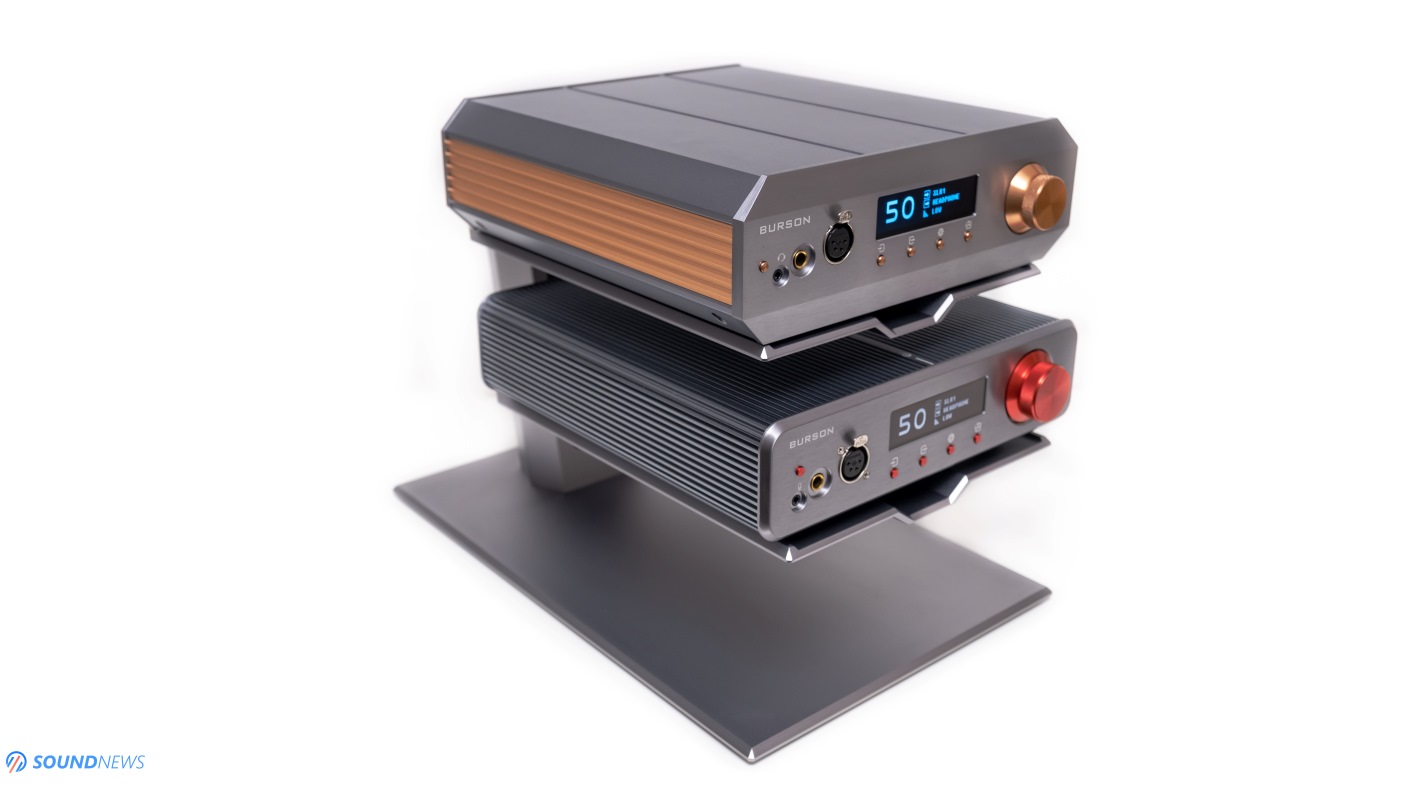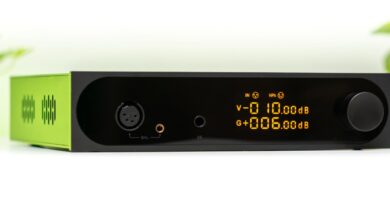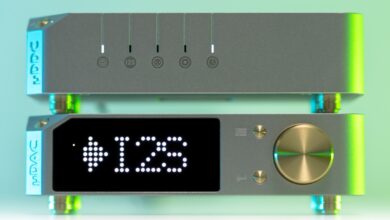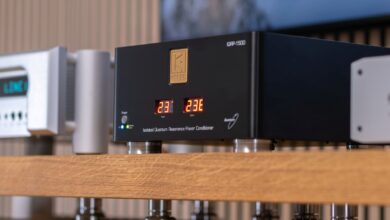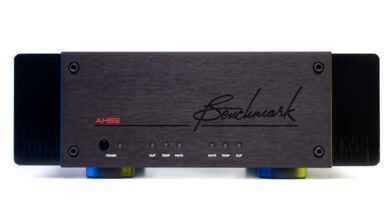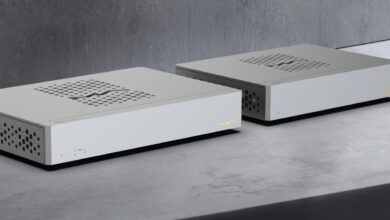Burson Soloist Voyager Review – Per Aspera Ad Astra
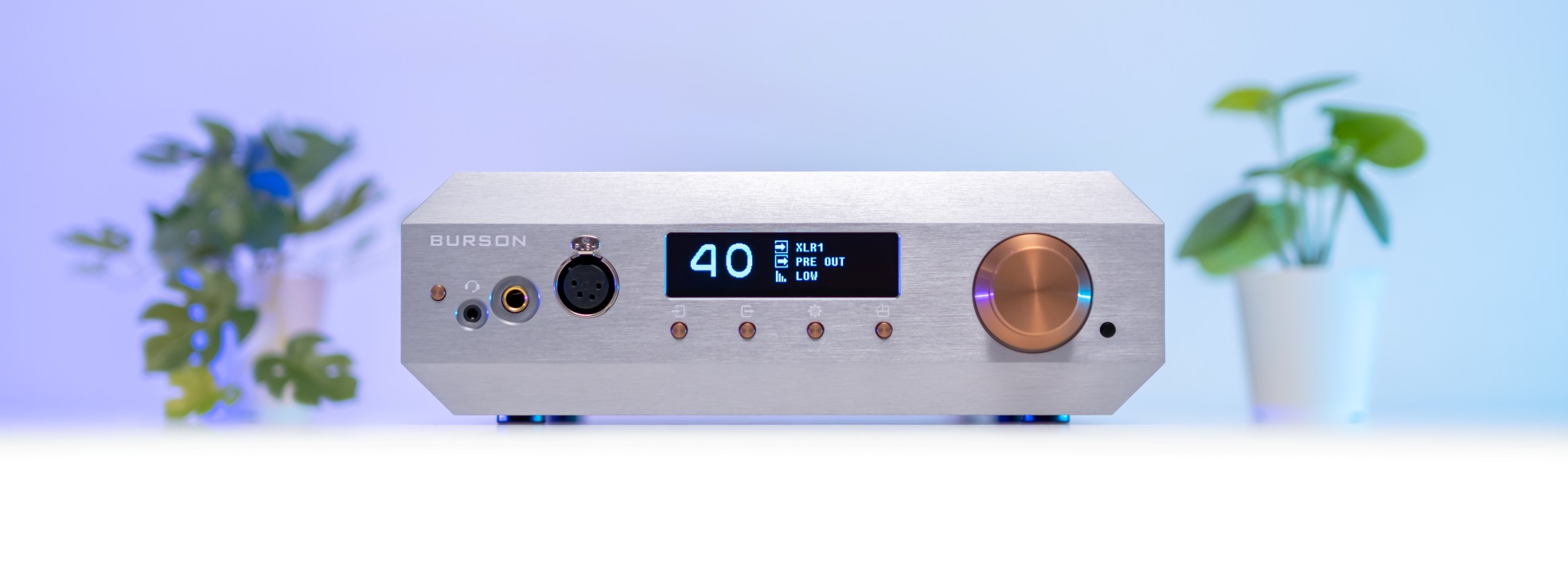
In the early days of space exploration, scientists discovered a rare alignment of the outer planets happening in the late 1970s. This presented a unique opportunity to visit them using a novel technique called gravity assist. The program, initially known as Grand Tour, was later renamed to Voyager and officially approved in May 1972. Voyager 2 launched 16 days before Voyager 1, taking a longer trajectory to reach Jupiter and Saturn but enabling it to encounter Uranus and Neptune later on.
Both Voyager 1 and Voyager 2 carried a special message aboard – a kind of time capsule intended for extraterrestrial civilizations, telling the story of humanity. As you might know, each Voyager spacecraft holds two identical phonograph records called the Voyager Golden Records. These records contain images and diagrams of our Solar System, DNA, and human anatomy, along with a captivating selection of music by renowned composers like Bach, Mozart, and Beethoven. As these probes continue their incredible journey through interstellar space, Burson Audio, the “mad scientists” from Melbourne, have built their own Voyager – a headphone amplifier and stereo preamplifier designed to launch your listening experience into interstellar nirvana.
Unlike its celestial namesake, this Voyager won’t leave you feeling cold and alone in the void. Instead, it will envelop you in the warm embrace of your favorite music. I’ve been a loyal Burson Audio enthusiast for as long as I can remember, having enjoyed their products on both headphones and loudspeakers. They’ve had their ups and downs, but each time they managed to surprise with even more audacious ideas. In less than two years, they released and then re-released their flagship headphone amp and preamp, which I had the pleasure of reviewing. Shortly after our Soloist 3 & 3X GT 2023 reviews were published, I started noticing some peculiar signs – the Voyager probes began appearing in my dreams, and instead of the usual electronic anthems and head-banging tunes, my imagination was filled with the melodies of Mozart and Beethoven. I couldn’t quite decipher these signs, but then, in late November 2023, Burson Audio unveiled a 3D render of their upcoming flagship – the Voyager, packed with surprises that I eagerly awaited exploring.
This Burson Voyager doesn’t hurtle through the vast emptiness of space in the same way as its namesake. Instead, it navigates the intricate landscapes of sound, amplifying your music with unparalleled ease and power. Forget the hiss and distortion that sometimes plagued their earlier creations; the Voyager boasts a completely redesigned PCB equipped with their self-developed Silent Power Module SP-02, achieving the lowest noise floor and highest signal-to-noise ratio ever measured on a Burson amplifier. The case has also been completely redesigned, resembling an alien spaceship more than the original Voyager probe. Naturally, this meticulous craftsmanship comes at a premium: $3,499 for the Standard Package and $4,199 for the Deluxe Package, which includes their brand-new V7 Vivid Pro fully discrete op-amps and the renowned Super Charger 5A power supply.
However, the Burson Voyager isn’t just about raw power. Just like the Voyager probes carried instruments to study distant worlds, this unit boasts an arsenal of features designed to meticulously dissect and enhance your music. So, ditch those tiny IEMs and prepare for liftoff. Whether you’re a seasoned sonic astronaut or a curious space cadet, the Burson Audio Voyager promises a more satisfying trip than any Earth-bound music experience. Remember, the universe is vast, and the sonic possibilities are endless.
Before starting the countdown, let’s address some tricky questions to the people behind this beautiful-looking unit.
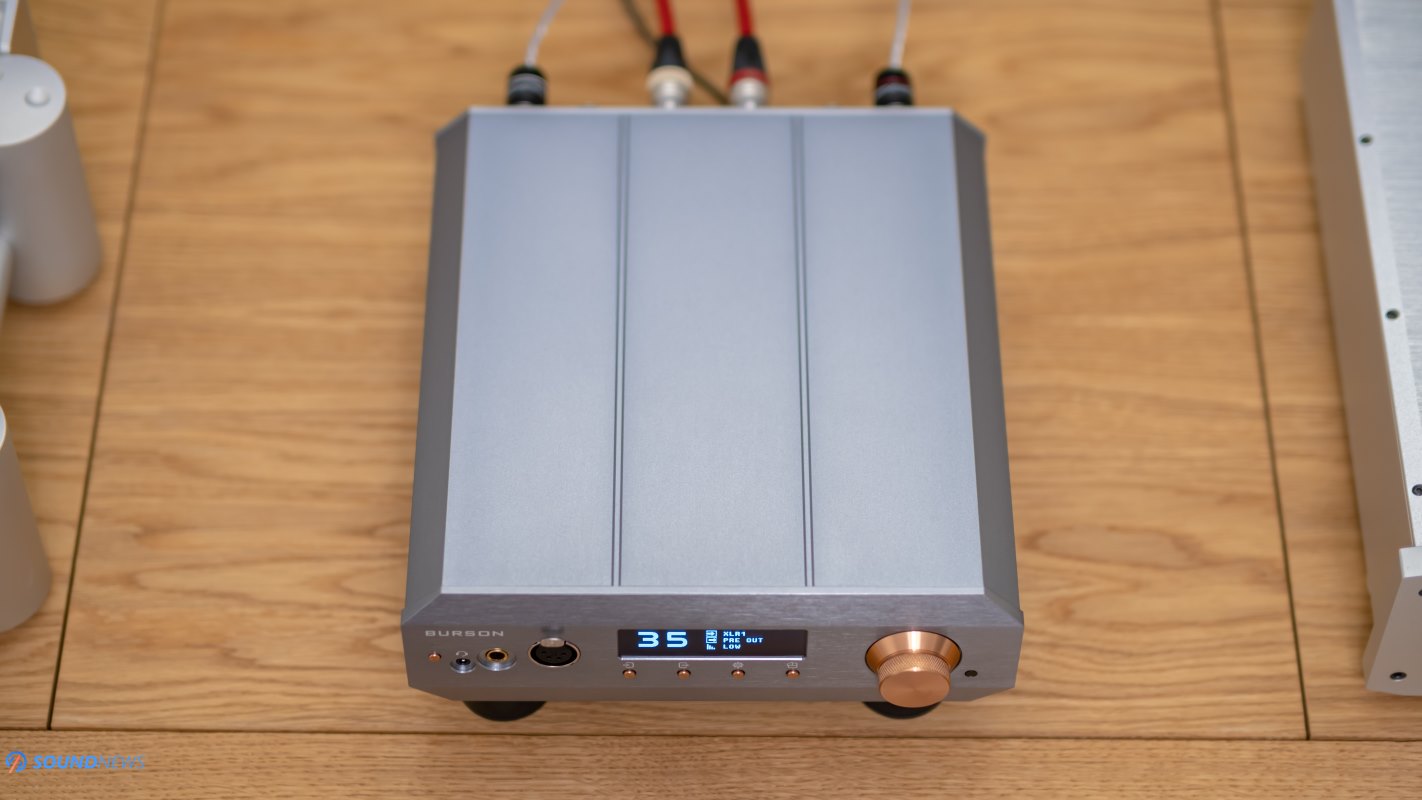
Q&A Session with Burson Audio
Q1: Having grasped the concept behind the Voyager, I’m curious if NASA’s Grand Tour program had any influence on the Soloist Grand Tourer’s design.
Burson Audio: Voyagers push boundaries and always aim to go further. That’s why we named our flagships “Voyagers,” as it embodies that spirit.
Q2: What was the core idea behind the Soloist Voyager as a statement piece?
Burson Audio: We always strive to blend performance, functionality, and aesthetics in our products. With the Voyager, we’re pushing the boundaries in each of these aspects to create a machine that we hope audiophiles will fondly talk about for years to come.
Q3: Does it operate in a deeper Class-A operation compared to the Soloist 3X GT, providing more quiescent current to the power transistors?
Burson Audio: Yes, and not just at the power transistor stage. There’s an increased current flowing into each of the four output stages along its signal path.
Q4: We’re puzzled by this one. Why release a new flagship headphone amplifier and preamplifier so soon after launching the Soloist 3X GT?
Burson Audio: The GT is our working-class hero: it works hard and plays even harder. With its various upgrade options, like Silent Power Modules, Op-amps, Super Charger, and more, the GT grows and evolves alongside its owner. The Voyager, meanwhile, caters to those seeking a deluxe package, delivered fully loaded.
Q5: Did the Soloist Voyager undergo a lengthy development period? If so, what were the main challenges encountered and how were they overcome?
Burson Audio: This project took more than 2 years from concept to realization. We designed a new output stage to overcome fluctuations in headphone impedance, especially with dynamic headphones, and created a brand-new enclosure. Every time we overcame one challenge, another ten emerged. Ha ha! Let’s just say that it took a lot of sleepless nights to get to where we are right now.
Q6: We’re curious to know if Voyagers will be added to the rest of the lineup (Conductor, Composer, and Timekeeper).
Burson Audio: That might be a good idea if we can offer something new. After all, to qualify as a Voyager, it needs to push boundaries.
Q7: The Soloist Voyager’s chassis runs hotter than other Soloists (around 60°C on lateral heatsinks). Do you have any tips or tricks for cooler operation and extending its lifespan?
Burson Audio: Running hot is an intentional aspect of its design, and we’ve selected components that operate well in high temperatures. However, similar to all Class-A amplifiers, it requires adequate ventilation space. Therefore, please avoid stacking books or draping a jacket over it. Additionally, do not place it directly above or below another high-current amplifier, like our Timekeeper GT. For the best setup, using a Burson Mothership is highly recommended. And, of course, remember to turn it off when not in use to conserve energy and reduce your electricity bill.
End words: Thank you for participating in our Q&A session, we can’t wait to see what’s coming next from Burson’s labs.
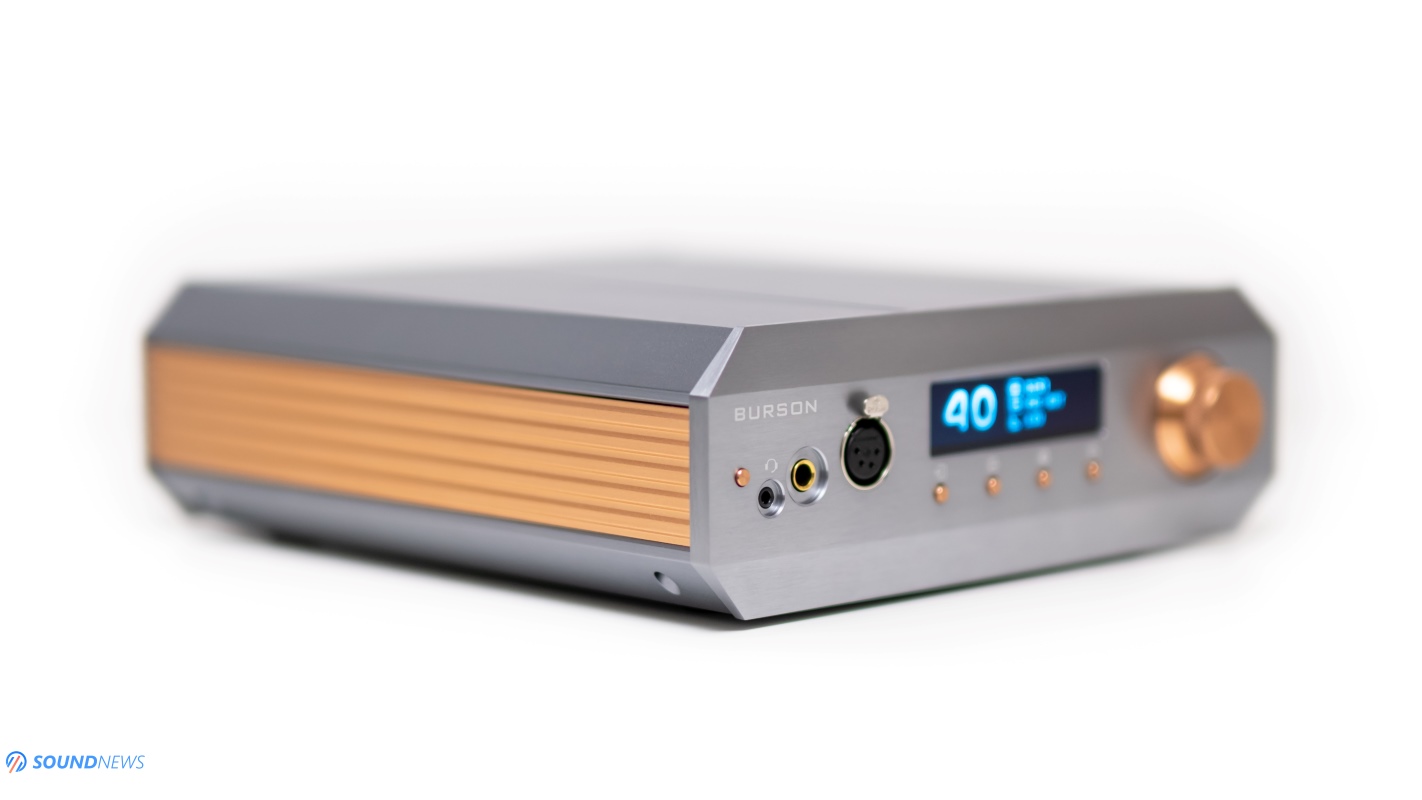
Design & Build Quality
The fact that Burson completely redesigned the PCB layout, the active cooling, heat dissipation mechanics, and the looks, already talks about the scale of this project. Knowing that the Cool Case was first introduced with the Conductor 3 Reference back in 2019 and later used in the rest of their lineup, I have a funny feeling that the Voyager case will be reused in upcoming product releases.
As for the Voyager itself, it looks more like an alien spaceship than like a Voyager probe, getting much taller and a hair wider compared to the regular Soloist GT, since on the bottom floor of the unit a custom cooling system was designed that moves hot air outside its case from an 80-Watt idling current flowing through its PCB. The unit looks way cooler, it’s fresh and modern compared to anything they have done before.
Before you ask, the orange elements that might appear as copper pieces are colored aluminum parts, and that includes the custom cooling system found on its back. Don’t confuse them with copper heat pipes that are usually used in cooling down blazing-hot CPUs and GPUs. An unexpected but welcomed change was seeing its tiny metallic remote, which looked like a miniature version of the Soloist Voyager. The same lines and geometry were used, including the color palette. The remote is a hair longer and heavier as well, things that I appreciate seeing on flagship units.
Since the Voyager gets hot after prolonged use, I took the liberty of gauging its case using a professional Bosch infrared thermo-detector, yielding the following insights versus previously tested Soloist 3X GT 2023 and 2021 variants.

It appears that the latest unit is running hotter compared to the old ones and you can feel that room temperature goes a little higher if you’ll be using it for several hours a day. These measurements were taken in a room held at 27°C, after powering them for an hour and a half. From this point onwards, their temperatures remained constant. If you already own a Cool Stand, then I need to inform you that the Voyager won’t fit in it, and I have a feeling that a dedicated stand is being developed as I’m typing this.
While almost 60°C is hot to the touch and you won’t be able to keep your fingers on it for more than a few seconds, the majority of its internal components were built to withstand much higher temperatures (around 100°C) on a 24/7 basis, so there’s no need for excessive concern. The Voyager runs hotter than the rest of their doings, but it’s in line with what I’m getting from Enleum’s AMP-23R and Trafomatic Primavera, primarily due to their 100% Class-A operation bias.
Given that the Voyager is operating in a deeper Class-A operation, active cooling was (again) implemented. However, after opening up its case I was unable to remove the main PCB and have a peek under it. I can’t say for sure how big is the fan or how fast it is spinning, but as much as I tried, I am unable to hear it in any condition or load. The unit is completely dead-silent and if that bothered you on the Soloist 3/3X GT, then the Voyager won’t be breaking the silence. The wind tunnel below the PCB is divided into three sections, out of which two sections pull in cool air and one section blows out hot air.
Once again, we’re treated with threaded volume wheels, offering a comfortable grip. However, I wish the physical resistance could be slightly higher, providing enhanced precision, especially with higher-sensitivity headphones. Burson Audio has relocated all the screws to their back panels for a modern and stylish look. Its case was once again CNC-milled out of raw aluminum. Short rubber feet are preinstalled, but you can always further elevate it from the ground by using third-party footers. The Iso-Puck Mini by IsoAcoustics adds 24mm of height to the unit, boasting a substantial elevation from the ground. If your listening station is crammed with electronics, cables, and various accessories, I’d suggest opting for third-party footers or using a dedicated rack that offers enough space for the unit to breathe.
With a bigger-than-usual case (265 x 270 x 85 mm) and weighing around 7 kilos (15.5 lbs), you can feel the added weight of the Voyager compared to the good old Soloists, which adds a level of confidence that I’m dealing with a serious kit of engineering.
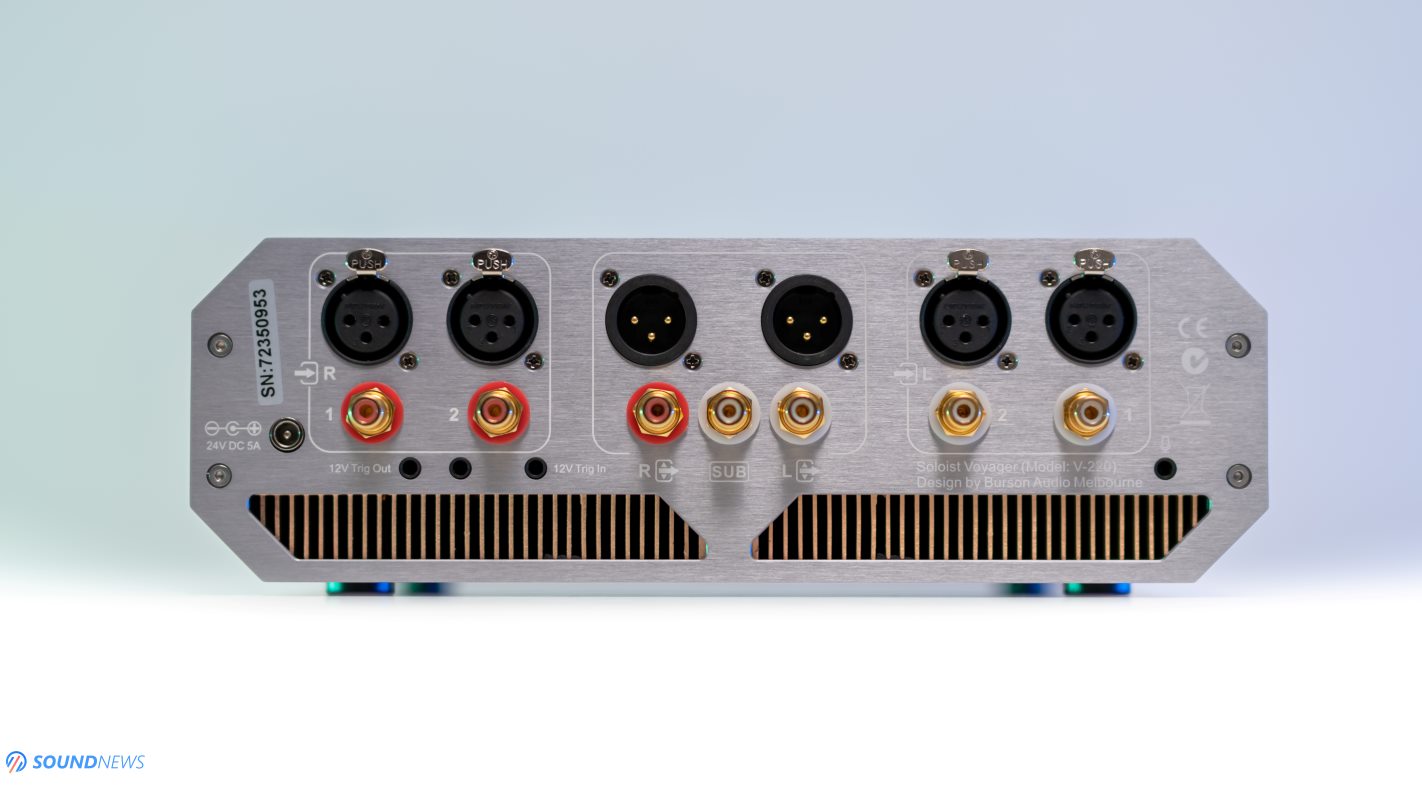
Controls & Connectivity
Its front plate plays host to a 4-pin XLR jack, a standard 6.35 mm headphone jack, and a 3.5 mm microphone input, catering to gaming headsets with 4 pole jacks. Arranged from left to right, you’ll find the On/Off button, input selector, output selector, settings button, and a button that flips the screen’s orientation. The volume wheel boasts a satisfying 99 steps, eliminating any guesswork about the available power. Positioned right in the middle, a blue-lit monochrome OLED screen might be compact, but thanks to its larger font, it remains easily legible even from a distance. This screen showcases crucial details, such as the volume level, selected input, output, and gain.
Taking a glance at the back panels, twin pairs of XLR and RCA inputs come into view, totaling 4 pairs of analog inputs. It can function as a high-performance preamplifier as well, and I’m informed that it’s quite a special-sounding preamplifier that should work well with a wide variety of power amplifiers or active loudspeakers. Additionally, it presents a single RCA subwoofer output. Beyond that, you’ll also find three triggers, an extra microphone input, and a 24V 5A DC input – responsible for powering the unit.
As you can see, it can be used either as a flagship-grade headphone amplifier or preamplifier, covering all our stereo and personal audio needs.
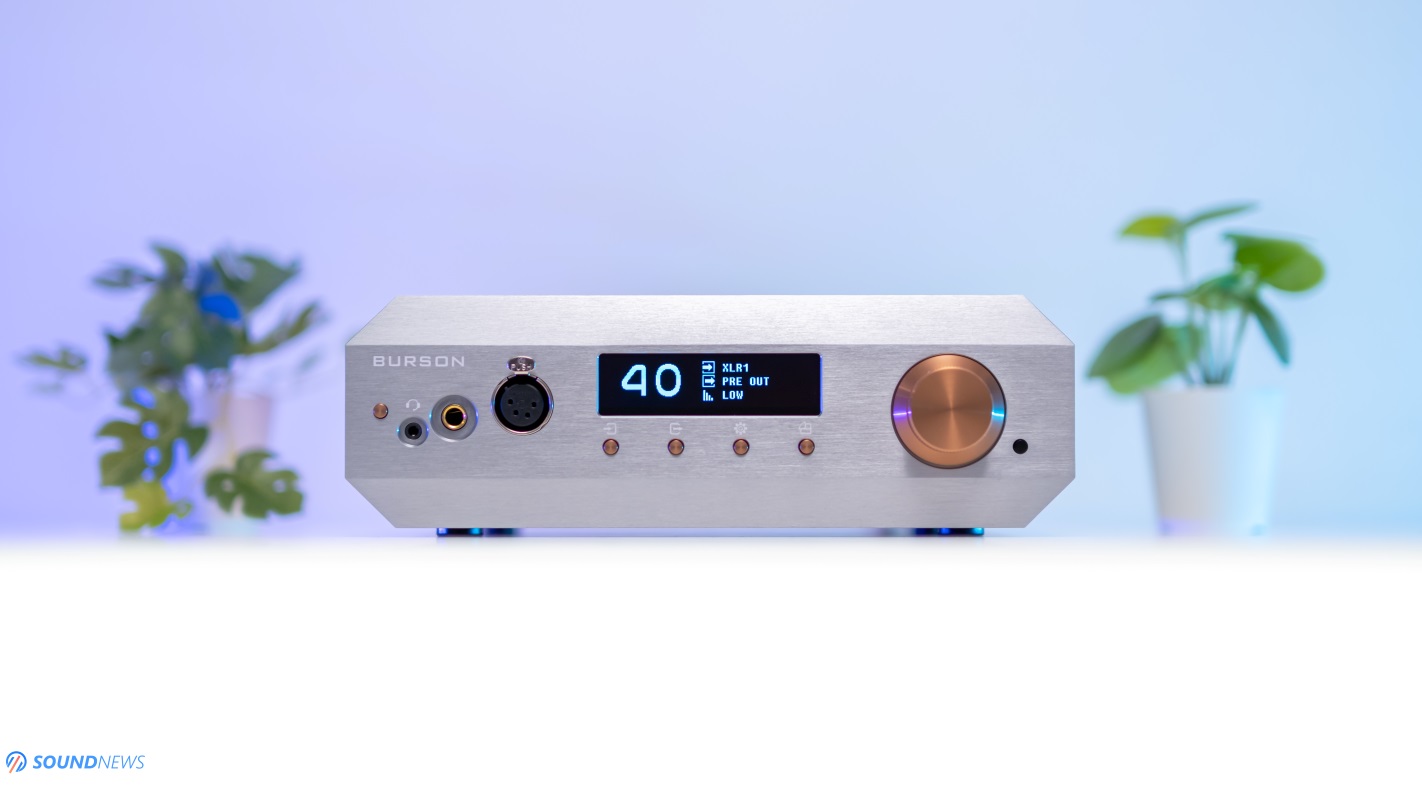
Display settings
The provided metallic remote empowers you to control various functions of the unit. You can tweak the volume level, mute or unmute, and switch between different inputs. Meanwhile, for more nuanced adjustments, delve into the user menu, where a gamut of settings awaits:
- Input: RCA1, RCA2, XLR1, XLR2
- Output: HP Out, PRE Out, HP + Subwoofer Out
- Gain: Low, Medium, and High – It will impact the gain of the headphone and preamplifier output
- LR Balance: Balances the Left and Right channels just in case you have hearing loss in one of your ears. This works with headphone and preamp outputs
- OLED Level: Low, Mid or High – sets the brightness levels
- Crossfeed: Off, Low, Mid, or High – half-century-old recordings weren’t made for headphone listening and you might experience an extreme stereo effect that doesn’t position the stage in the middle. For that reason, you can play with their crossfeed settings and make those recordings less fatiguing in long listening sessions, centering the stage for a more natural listen
- Remote: On or Off – self-explanatory
- Reset Set: Yes or No – resets to factory settings
- Auto Off: Off keeps its display engaged at all times, On turns off the display after a minute of inactivity
- While many of these settings are typically configured once and left untouched, the inclusion of this meticulously detailed user interface is commendable for catering to the tech-savvy audience
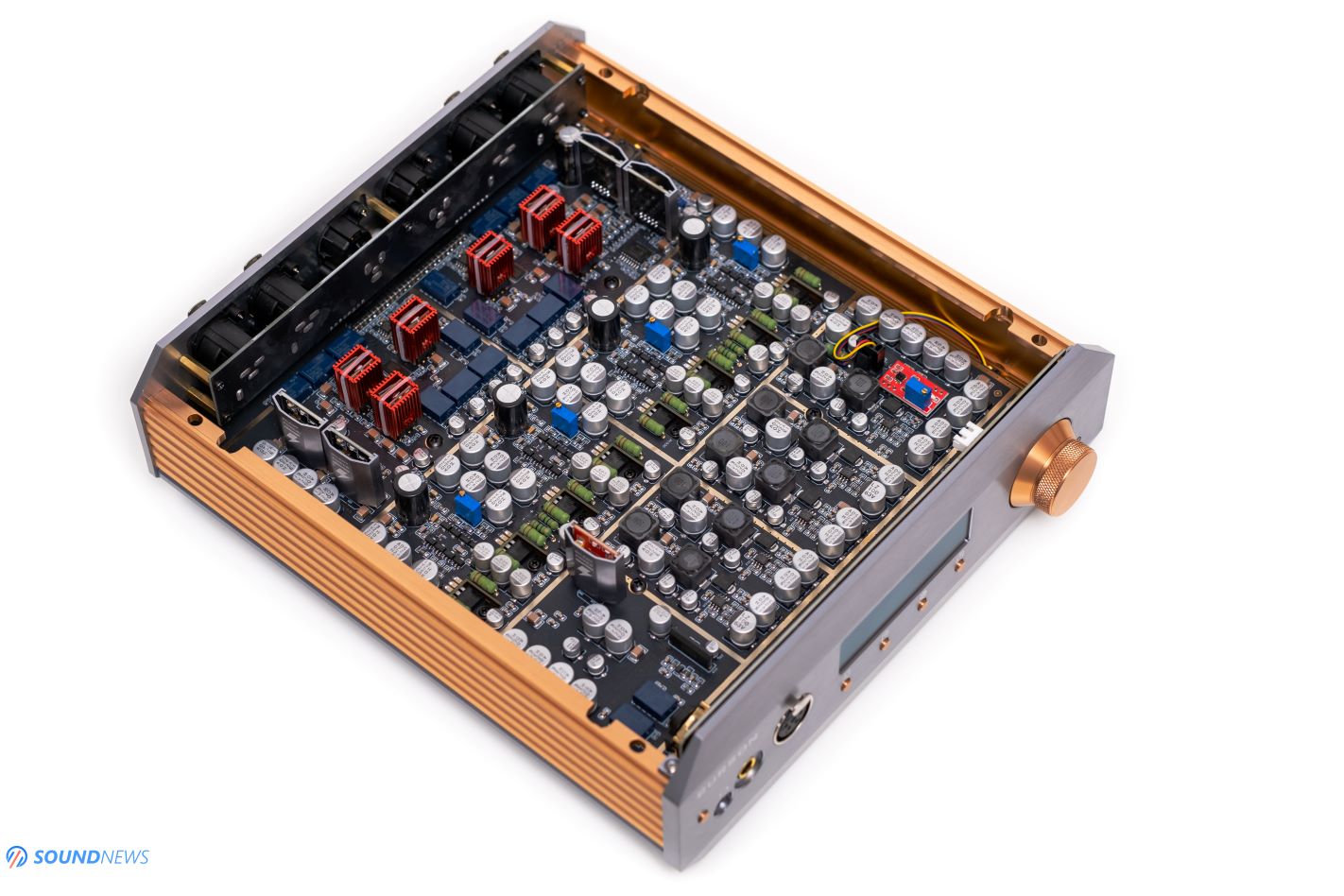
Under its Hood
“The Soloist Voyager stands as our top-of-the-line headphone amplifier and preamplifier. From the inside out, you will not find anything conventional. From our voltage and frequency-boosting Max Current Power Supplies to our renowned discrete audio op-amps, and from our Silent Power regulators to our cost-no-object mono-channel volume controls, every element—including its enclosure, which provides critical cooling—has been engineered from the ground up to push the boundaries of audio experience, doing so in absolute style.”
So here we have it, this is the biggest, the meanest, and the hottest headamp and preamp that Burson has ever made. Class-A and pure Class-A are distinct things and it seems that the Voyager never switches its power transistors, not only that but a higher quiescent current now flows through them and the rest of the components.
This is once again, a fully discrete, fully differential, and fully-balanced Pure Class-A headphone amplifier and preamplifier, that uses 8 MOSFET power transistors, six V6 Vivid or V7 Vivid PRO (Standard or Deluxe package) discrete op-amps, five sets of Max Current power supplies and their best fully analog volume implementation yet. While not that much time passed since the Soloist 3X GT release, they are fine-tuning the Voyager for a very long time, incorporating all the knowledge they gathered in 20 years of making all sorts of amplifiers.
Power-wise, we have 10 juicy Watts per channel in 16 Ohms via the 4-pin XLR jack and half the output via the regular 6.35mm jack. If you have a feeling that you’ve seen those numbers before, then you’re totally right! However, if you consider that these 10 Watts per channel are identical to those coming from the Soloist 3X GT, then you’re totally wrong! Biased into a pure Class-A operation, the Voyager will get the upper hand when controlling low-sensitivity headphones AND high-impedance ones versus any other Burson-made amplifier.
You can spot six V6 Vivid/V7 Vivid PRO op-amps pre-installed, four used at the input stage and two are buffering its volume control chips. All of these are swappable and will have an impact on the sound, although the fantastic four used at the input stage will have a bigger impact on the final sound. The V7 Vivid PRO and V7 Classic PRO op-amps that were just released, use power transistors (instead of diodes and resistors) biased into pure Class-A operation, these are something else entirely, and if you want to experience the ultimate sound that Burson envisioned with the Voyager, then I strongly suggest going with the Deluxe package that swaps the V6 Vivids with the V7 Vivids PRO. Like the Soloist 3X GT unit before it, the Voyager is a dual-mono, fully symmetrical design, meaning that we have two single-ended amplifiers in the same chassis, one amplifier will be driving one cup and the second one will be driving the other headphone driver if the 4-pin XLR output is being used.
I’ve been checking out PCB layouts for two decades now and I must say that the Voyager looks like a Bridget Riley’s painting on the inside. It’s simple, yet complicated, following strict geometric rules, using some of the best audio components money could buy.
It needs to be mentioned that the brand-new silent power modules (SP-01) which were introduced with the Soloist 3/3X GT 2023 lowered the noise floor significantly versus their older designs. However, we have four God-tier SP-02 ultra-silent power modules on the Voyager for the lowest possible noise floor.
The MUSES 72320 volume control chips are usually found in the world’s best preamplifiers and again, we see them in the Voyager. As I have mentioned above, these volume control chips are buffered with V6 or V7 Vivid PRO op-amps, lowering the channel crosstalk in the process. Channel separation went up and a dedicated preamplifier is no longer needed for a perfect channel balance.
As was the case with the 2023 versions of the Soloist 3/3X GT, the volume is more linear and less logarithmic and you’ll be getting slightly more power early on, getting a finer volume control across the board. Please don’t get upset seeing those external switching-mode power supplies, as their actual power supplies are sitting inside it. A total of five MAX Current Power Supplies (MCPS for short) were used, raising the voltage frequency from 50-60 Hz to 170 kHz, pushing the noise floor far beyond human hearing and the low impedance output ensures abundant and instant energy on the spot.
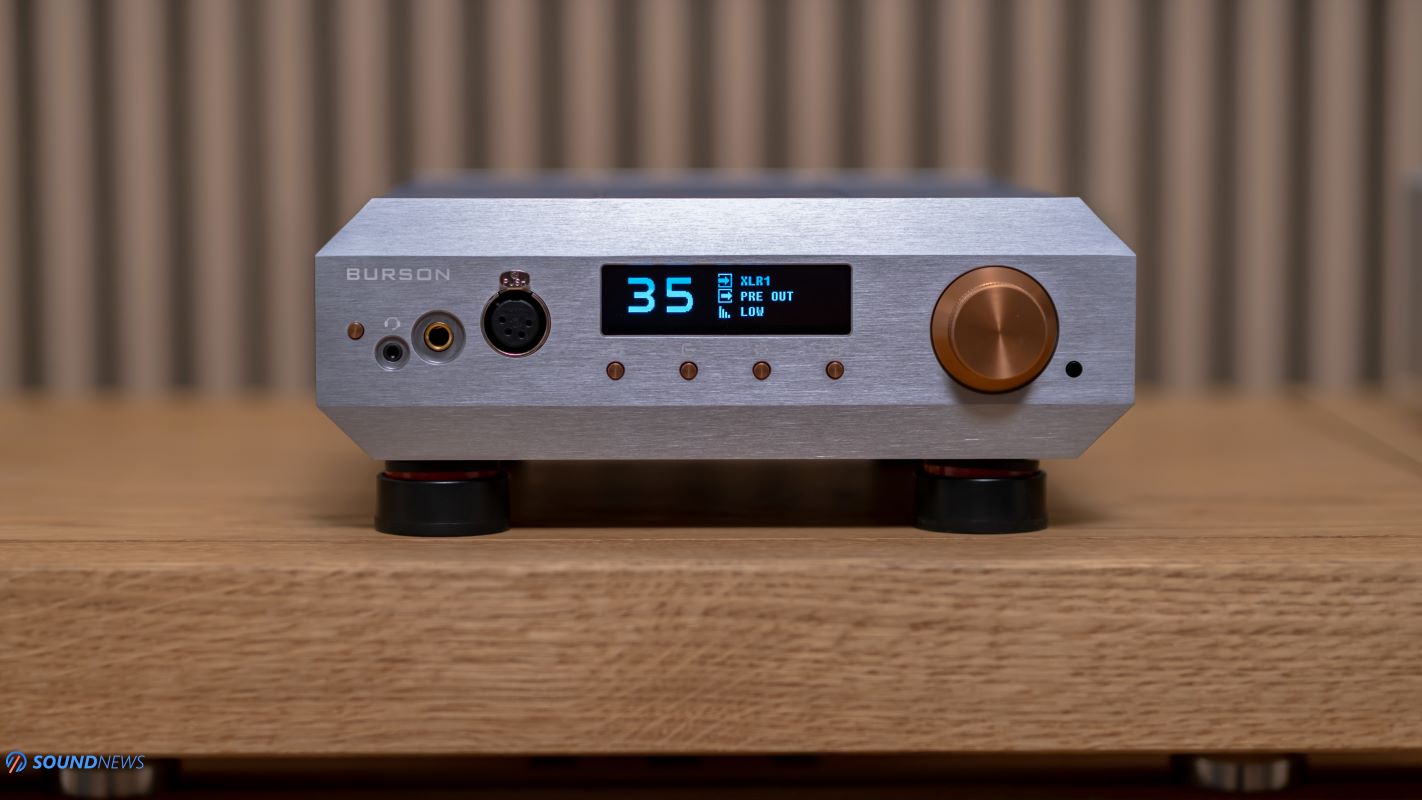
Test Equipment
The Voyager proved to be extremely versatile, finding a place in both a stereo and head-fi battle station, and that’s why I used it in two distinct setups:
- In my office, it served as a dedicated headphone amplifier alongside a Rockna Wavedream Signature DAC and Rockna Wavedream NET 4Tb Roon Server / Music Server / Wired streamer. It’s worth mentioning that I took measures to ensure optimal performance, including completely isolating the Ethernet connection with two media converters (Ethernet > Optical > Ethernet) and powering both converters and the wireless router with a KECES S14 linear DC power supply. All five components were also powered by a Plixir Elite BAC1500 balanced and isolated power conditioner.
- Later on, I moved it to the living room working as a preamplifier that was controlling Chord Electronics Ultima 5 power amplifier. The Wavedream NET 4TB still served as the Roon core fed by the Ansuz Power Switch D3, followed by the Wavedream Signature. All five units were powered by a KECES IQRP-1500 balanced passive power conditioner.
All right, everyone, my body and soul are ready for some well-deserved music, so let’s hit some eardrums!
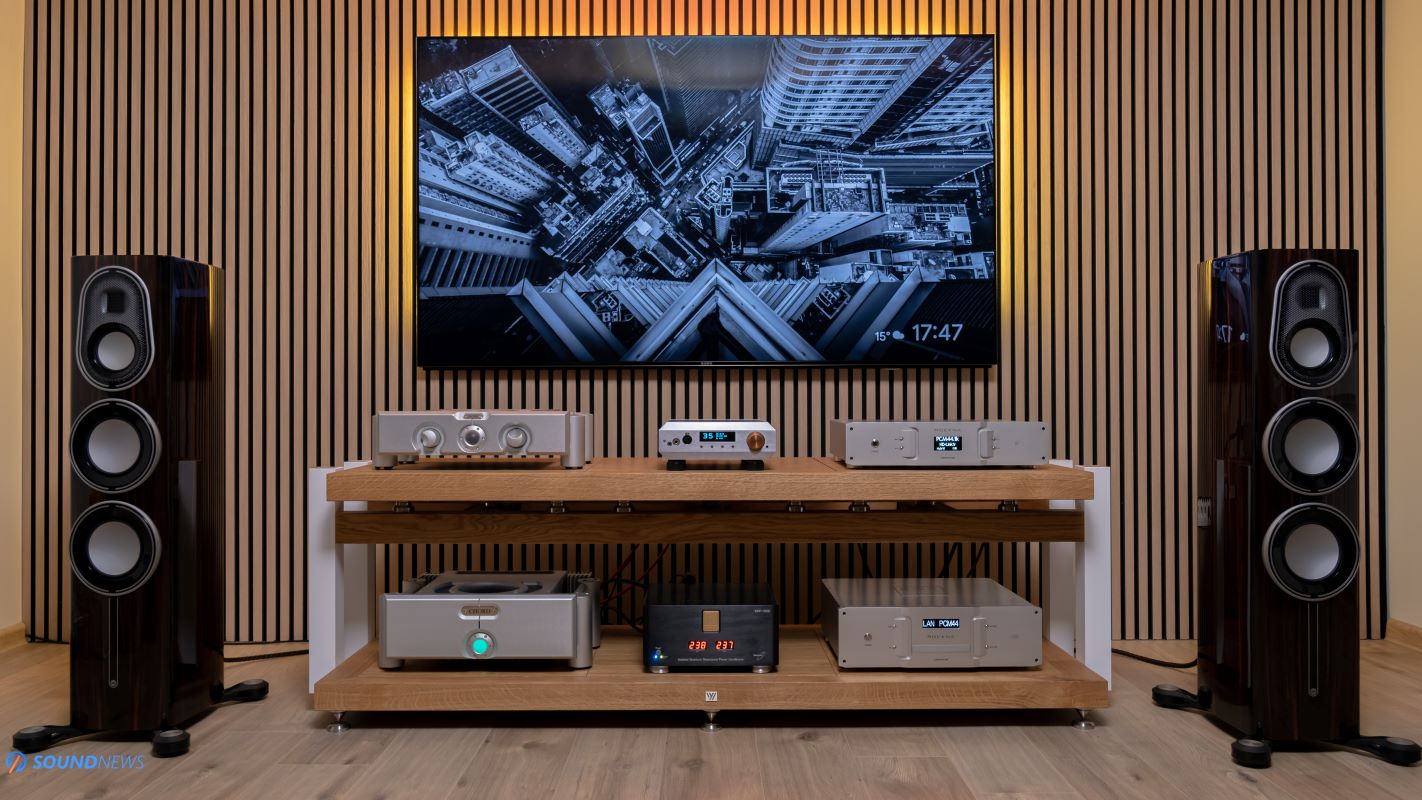
Sound Performance
I. Preliminary Sound Impressions
There’s always a thin line between high-end audio and end-game material. The former is about getting everything right in terms of technicalities like resolution, fast transients, soundstage, and imaging while keeping the noise floor as low as possible. The latter is a whole different story, as, besides everything that high-end audio already offers, your body should also react to the overall experience. You need to feel on top of the mountain, your imagination needs to start doing its mojo and goosebumps need to appear all around your body.
An apple won’t fall far from the tree and if you ever tried any of the Burson-made headphone amplifiers and preamplifiers, then the Voyager will carry a similar tonality and everything you liked about them will still be present. After working for several weeks in both a stereo and head-fi battle station, it was clear to me that Burson didn’t want to alter their winning formula, working hard on minimizing the issues people had with their previous units.
I still feel that a more refined version of the Soloist 3X GT 2023 is singing tunes to me, but these tunes have a longer natural decay, the overall tonality of the amp went closer to the real thing, and the music is now always hovering at an arm’s reach, all while marginally boosting the resolution and the transparency of the music. I’m still using the Enleum AMP-23R daily, as nothing could match its resolving abilities and the natural flow of the music. The ease that AMP-23R always carries with slow and mellow music and its darker side awakening when aggressive music starts playing are some chameleon-like skills that I didn’t encounter before with personal audio. I always resonated with that one, like looking in the mirror.
The AMP-23R finally found a proper challenger and finally, there’s an amplifier that provides a similar skill set. Listening to ritualistic folk songs transposes my mind somewhere else and if the Voyager is capable of teleporting my thoughts, stopping me for a few moments, trying to digest everything that I’m experiencing, then clearly, Burson’s best isn’t only highly technical, but also highly emotional, always sending cryptic messages for you to decipher when music does its thing.
The subtle, yet impactful improvements that Burson made with the Voyager, removed all remaining traces of digitus that 3X GT was still having with a few particular headphones, the Voyager no longer over-sharpens the treble as a Damascus blade, it’s still sharp enough, but not as to bother with aggressive or treble intensive tracks. Treble in general, is something that I’m always focusing my attention on, trying to find a balance between getting a crisp, sparky treble that extends beyond our hearing abilities without getting too much attention. That’s a risky quest line that few amp builders accomplished.
The very first thoughts that the Voyager planted inside my head were impressive dynamics! Powerful, merciless, nut-kicking dynamics that were adding oomph to the bass and life to the midrange. The unstoppable force of the music had a clear road ahead, receiving an instant rush of dopamine that could still be felt throughout the rest of the day, but before telling the whole story, we need to discuss the newest breed of discrete op-amps that Burson have just unveiled.
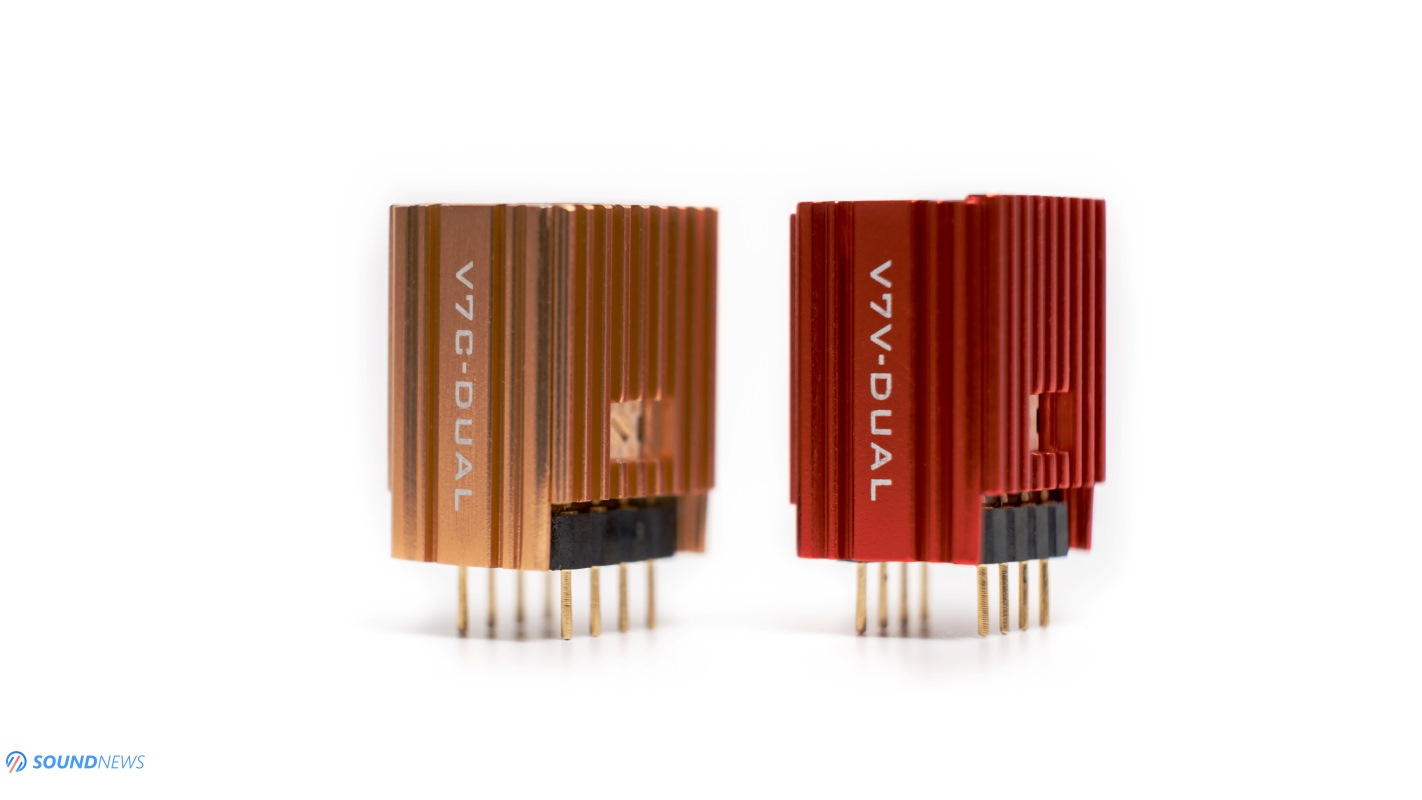
II. V7 Vivid PRO VS V7 Classic PRO Discrete Showdown
Fortune favors the bold and if you were brave enough to preorder the Soloist Voyager, then you got a pleasant surprise with your purchase – 6 brand-new pieces of V7 Vivid PRO discrete op-amps pre-installed, together with a Super Charger 5A at no extra expenses. At this moment, the Deluxe package is offering these goodies to you, and please don’t get upset if you got the Standard package, as Burson will start selling these V7 Vivid PRO op-amps in the coming weeks.
But wait a second, there’s more! Besides the V7 Vivid PRO, the V7 Classic PRO was also revealed and it seems that I’ll be the one to take these babies for a spin. For starters, both V7 variants are now coming with an aluminum heatsink wrapping the whole IC like a metallic blanket, for better heat dissipation. We can finally discard horrifying pictures of melted V5 and V6 op-amps in the wild. Luckily, that won’t happen with any of their V7 offerings. You still can’t use them in battery-operated headphone amps and DAC/AMP combos, due to having a height of 25mm (or 1”) without the DIP-8 socket installed, but you can install these anywhere else if you have the space to accommodate them.
After playing with both variants and getting higher temperatures all around, I’m pretty sure these are biased into a deeper Class-A operation – which is always a good sign for better performance. Instead of using tens of tiny resistors and diodes that I’ve seen on the V6 variants, two power transistors seem to be used this time around with a thermal compound in between them and the aluminum outer shell. Even without listening to them, I see lots of upgrades versus the old V5 and V6 variants and I’m pretty sure we’ll get even wilder dynamics, a faster overall sound, and a higher resolution, knowing that we already have a lower component count and a shorter signal path. Without further ado, let’s check how both are singing in the Voyager.
Before making any sound observations, I needed to cook them for at least two days, as power transistors usually need at least several hours of use before entering optimum working parameters, and since the Voyager gets a little hotter than usual, I burned them in for 8 hours a day, 3 days straight.
After exchanging all 6 pre-installed V7 Vivid PRO with the Classics, there was an immediate change in the tone of the music. If you already checked my Big Grand Tourer Battle (chapter II), where I compared the Soloist 3X GT 2023 with the single-ended only Soloist 3 GT 2023, then I’m getting very similar vibes from the Vivid vs Classic comparison. The stock V7 Vivids PRO were all about getting the last drop of resolution from your amplifier, revving up louder with fast-paced tunes while delivering a somewhat faster start and stop of the drivers. The Vivids have a faster transient response that covers the entire frequency response while adding slightly more power to the low-end delivery. The sound is also extremely detailed! So much so, that I do not have currently in my possession or on loan, a similarly resolving Class-A amplifier, except for Enleum’s AMP-23R. The Voyager takes the already impressive transparency of the Soloist 3X GT to greater heights and if your downstream equipment is up to the task, then the added resolution feels substantial, to say the least. I can’t fault the Vivids, they go in and out in split seconds, delivering a fresher sound compared to the Classics.
V7 Classic PRO on the other hand will be offering the good old transistor sound of vintage amplifiers. I’ll go with a wild guess what MOSFETs have been used instead of Bipolars, which usually add more meat on the bone, more texture, weight, and richness to the sound, while gently slowing down the pace and letting us completely relax and soak in every note and nuance. The Classics worked wonderfully with acoustic instruments, the vocals were soothing and a little sweeter – without emphasizing the S sounds. I completely detached myself while testing these on music by Peia Luzzi, Porangui, Eric Zang, Mari Boine, Nessi Gomes, Ajeet, and Nattura.
While the resolution takes a minor hit and so does the transient response and decay of the notes, V7 Classics PRO are transforming the Voyager into a warm, sweet, and quite seducing-sounding amplifier, completely discarding its mean and aggressive character. The gap between Enleum’s AMP-23R and the Voyager is shrinking considerably with the Classics installed and I could finally use a wider variety of digital transports and DACs since system matching is no longer a concern with the V7 Classic PRO op-amps. Please take note that I’m currently listening with my eyes closed, trying to amplify every impression that comes forward, and if I were casually listening, then the differences wouldn’t be as dramatic and clear.
What surprised me is that I no longer get a substantial difference in imaging and soundstage as was the case with the V6 comparison back in the day, as the Voyager always sounded grand, open, and wide on all axes, things that we usually reserved for the Classic op-amps on the Soloist units. I want to be clear that V7 Vivid PRO never lacked naturalness or a warm midrange presence, in fact, the Voyager by default is already a sweeter-sounding creature compared to anything they’ve done so far, but with the V7 Classic ICs in place – the overall tonality takes a radical shift, getting even sweeter and smoother sounding. It’s like comparing a brand new 986 horsepower twin-turbocharged SF90 Ferrari with lots of high-tech electronics installed, with a beautifully preserved Ferrari 330 SWB with just 240 horsepower under its hood, that lacks any high-tech electronics. Both are beautifully crafted and built to the highest standards, but you’ll be getting world-apart driving experiences.
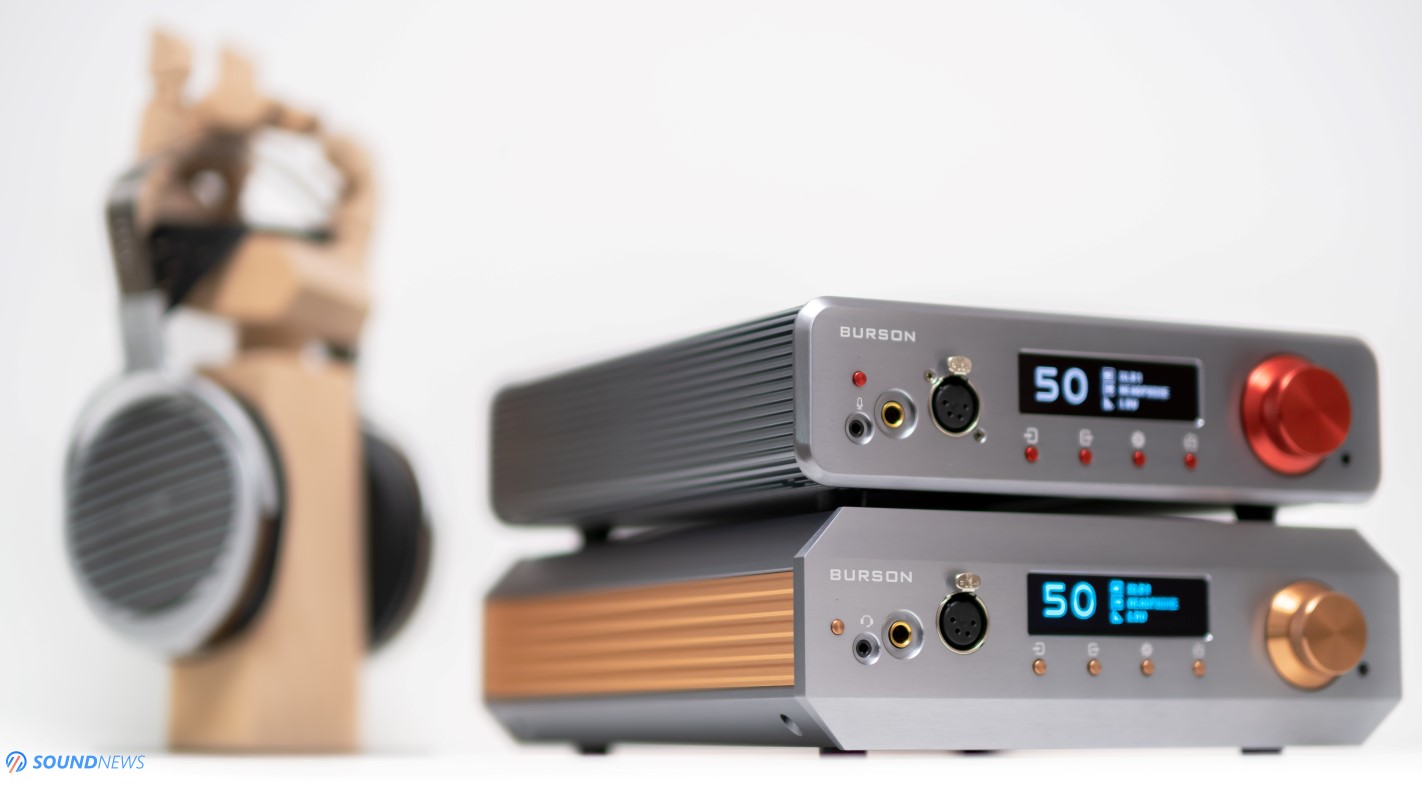
III. The Battle of The Soloists
Soloist Voyager Deluxe ($4.199) VS Soloist 3X GT 2023 Deluxe ($2.799)
I wish we would be comparing the voice of Ronnie James Dio with Ozzy Osbourne, Mercedes Sosa with Joan Baez, or Axl Rose with Kurt Cobain, but I’ll be comparing a different breed of soloists today, clad in shiny aluminum armor, waving similar specs and power ratings. Some of you already own the latest Soloist 3X GT and I’m sure you are as curious as I am about how it compares with their latest and greatest.
I’m using the pimped-out Soloist 3X GT 2023 (Deluxe package), including the optional SP-02 silent power modules, for the lowest possible noise floor and the highest signal-to-noise ratio. The Voyager already comes preinstalled with the SP-02 and Super Charger 5A power supply, swapping the V6 Vivids with the PRO grade V7 Vivids biased into a deeper Class-A operation.
The first thing you’ll observe will be the heat coming from the Voyager, which is on average by ~11°C (~51.8°F) hotter compared to the 3X GT. We have a much smaller fan on the Voyager which doesn’t blow the air out through an open-air vent but through several heat dissipation fins located on the back of the unit. You cannot hear the cooler spinning on the Voyager, I tried disassembling the unit and checking out the size and RPM of the cooler, but removing the PCB seemed a much harder task and since I didn’t want to damage anything, I assembled it back. Once both units reached their optimum (read: highest) temperature, I prepared a refreshment, reclined my chair, and commenced a long listening session.
The Soloist 3X GT is a marvelous-sounding headphone amplifier and you’ll be hardly pressed to find a better-sounding one at its respective price point. The preamplifier section is equally impressive and together with the Timekeeper GT, you can form a relatively small stereo setup that won’t occupy lots of space, but sound up there with some of the nicest units. You can certainly do better and at the moment I’m using a better preamp and power amp, but those are costing together about ~5 times as much. Do the Chord Electronics Ultima 3 Pre and Ultima 5 Power sound 5 times better? Of course not! Who I am kidding here, diminishing returns are kicking in full swing.
Given that you already checked my original Soloist 3X GT review and then my re-review of the updated 2023 version, now, imagine that the slight grain in the treble and the slight “S” emphasis are no longer there! Imagine that the resolution went a little higher, there is more information coming at you, all while getting less treble sharpness. Inconceivable, right? But that’s exactly what you’ll be experiencing with the Voyager: a more pleasing sound that no longer offends even with the hottest-sounding headphones, loudspeakers put on the most aggressive tunes out there. The Voyager has a more soothing voice, you hear it roaring loud and clear, pounding your eardrums with an incredible sound pressure level, and yet…everything seems at the right place. The slight aggressiveness and edginess are no longer there and if you want to completely eradicate every notion of brightness, then the V7 Classics PRO are doing that by a hair better.
When you start playing with low-sensitivity headphones like Hifiman’s Susvara, DCA’s Stealth and Expanse, Abysses and Mod House Tungstens, you start realizing that headphone drivers are no longer rattling, never trying to find a balance between slow and fast passages, always keeping their pace in line with fast transients. Going from down tempos to up tempos and from low to high dynamic swings happens more naturally, like there is more power reserve remaining on tap, even if on paper, there isn’t more power available. The quality of the power improved and you can feel an added layer of refinement which isn’t quite there on the Soloist 3X GT. Now, you can further elevate the 3X GT by adding the V7 Vivid PRO or the V7 Classic PRO and I’m sure, it will nicely respond to those subtle upgrades.
Subjectively speaking, yes, there is quite a difference between them and blind tests weren’t quite necessary, as the differences weren’t minor if super-revealing headphones were used, together with world-class digital transports and D/A converters. The Voyager is exactly what I’ve been dreaming of getting from the Burson team. I wanted to have explosive, crazy dynamics that could shatter my eardrums if needed and the only thing I still longed for, was a nicer control over the treble area, with an added liquidity that would make me recline my chair, and go with the flow. The so-called “flow” is part of the Voyager diet and you’ll be experiencing it immediately. The single-ended Soloist 3 GT also had plenty of flow and effortlessness, but here, everything was dialed up by a notch or two.
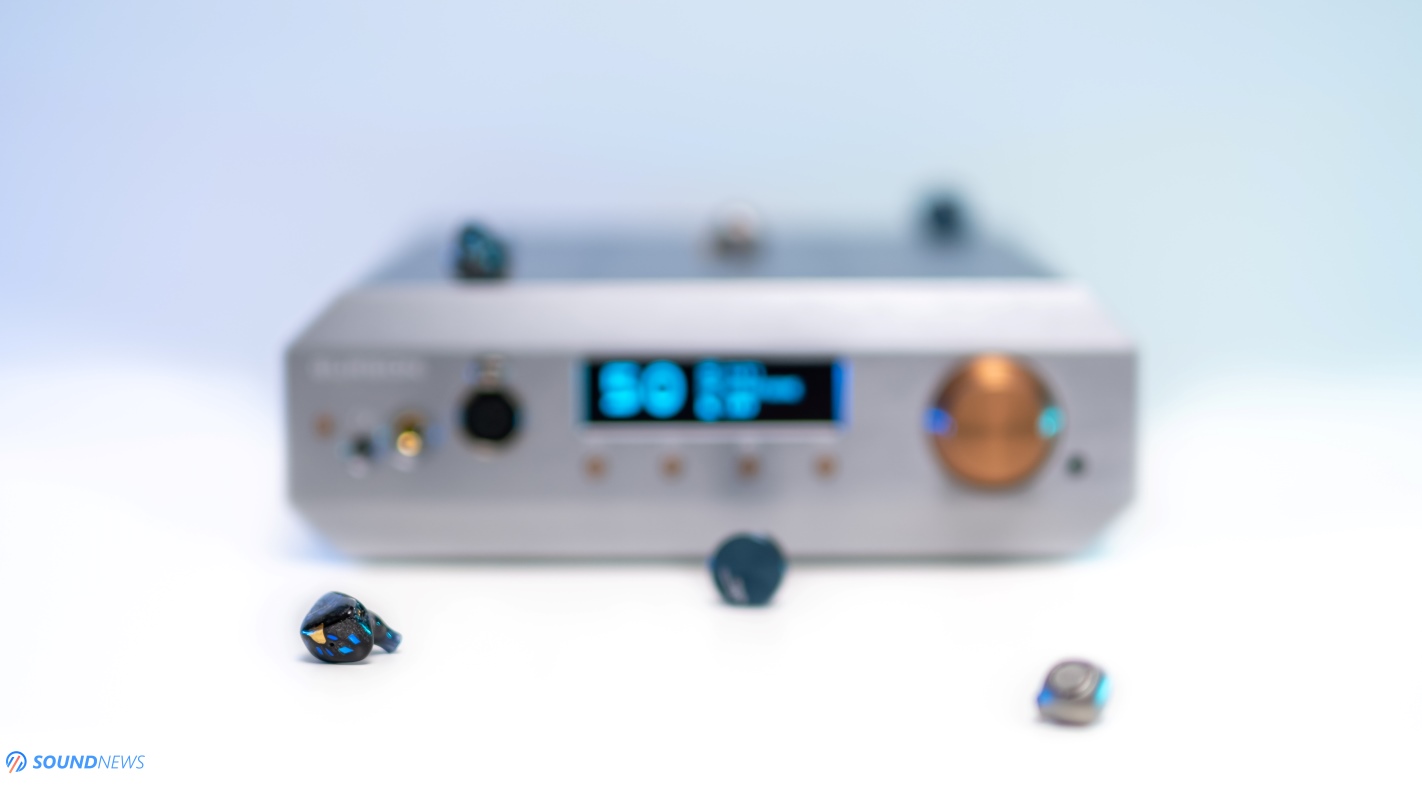
IV. Noise Floor & IEM Compatibility
With a net weight of 7 kilos, pushing 10.000 mW per channel out of which a single mW is needed for a pair of FiiO FX15 to reach an excruciatingly loud SPL of 103 dB, the last thing you would do is connect a damn pair of sensitive IEMs to this beast.
The truth is however, that a lot of folks are driving their entire collection of IEMs, portable and desktop headphones with a single unit and I’m sure many are scratching their scalps, wondering if the Voyager would induce or reduce noise levels. Before I reveal the big mystery, I need to reiterate that fully discrete amplifiers like this one have considerably more components than regular op-amp-based amplifiers. More components will generate more noise of their own and that’s why such amplifiers aren’t regarded as best buddies for sensitive loads. When you create all-discrete amplifiers with several times more components than traditional IC-equipped units, noise becomes a much bigger challenge. I have tested most solid-state Class-A headphone amps around here, and honestly, very few were noiseless with sensitive IEMs at normal listening volumes, let alone at maximum volume with music on pause. Of course, nobody would listen at extremely loud volumes, but it’s comforting to know that the noise is completely eradicated regardless of the volume or the load.
Some of the quieter amps that have been tested around here, usually had a thin body waist and a petite footprint, weighting little to nothing, due to a low number of components, short signal path, and simplified circuity.
The other problem with a powerful desktop amplifier is that when the power goes up, so does distortion and noise. Since we’re talking about the most powerful headphone amplifier made by Burson, extra care went into crafting a more refined circuitry with their newest creation. The good old 3X GT had a little bit of residual noise with sensitive IEMs I had in possession, not only that but when I was engaging its user menu, a buzzing noise would zap my eardrums until I would press the menu button again. The buzzing noise is no longer an issue on the newest 3X GT and 3 GT 2023 units and I’m getting similar results with the Voyager. I’m happy to report that the noise floor is no longer increasing in intensity when accessing the user menu or changing the brightness, but what surprised me is that when changing the gain, the noise only barely goes up.
When the music plays, I can’t hear anything bothering me, but once I’m pausing the music, there is a faint noise with a set of FiiO FX15 and HiBy ZETA which are the most sensitive IEMs in my possession. The noise is a hair lower compared to the current production 3X GT and much lower compared to the first-gen 3X GT, but there is still some faint white noise playing in the background.
You need to have a slight dose of madness using IEMs with such a powerful unit, but I could use a few IEMs with their newest amps, although not the most sensitive ones. 7HZ Timeless AE together with HiFiMan Svanar were dead silent even when going louder, and in the end, it depends on the load and sensitivity, but I see myself using a dozen IEMs without ever bothering about the noise floor.
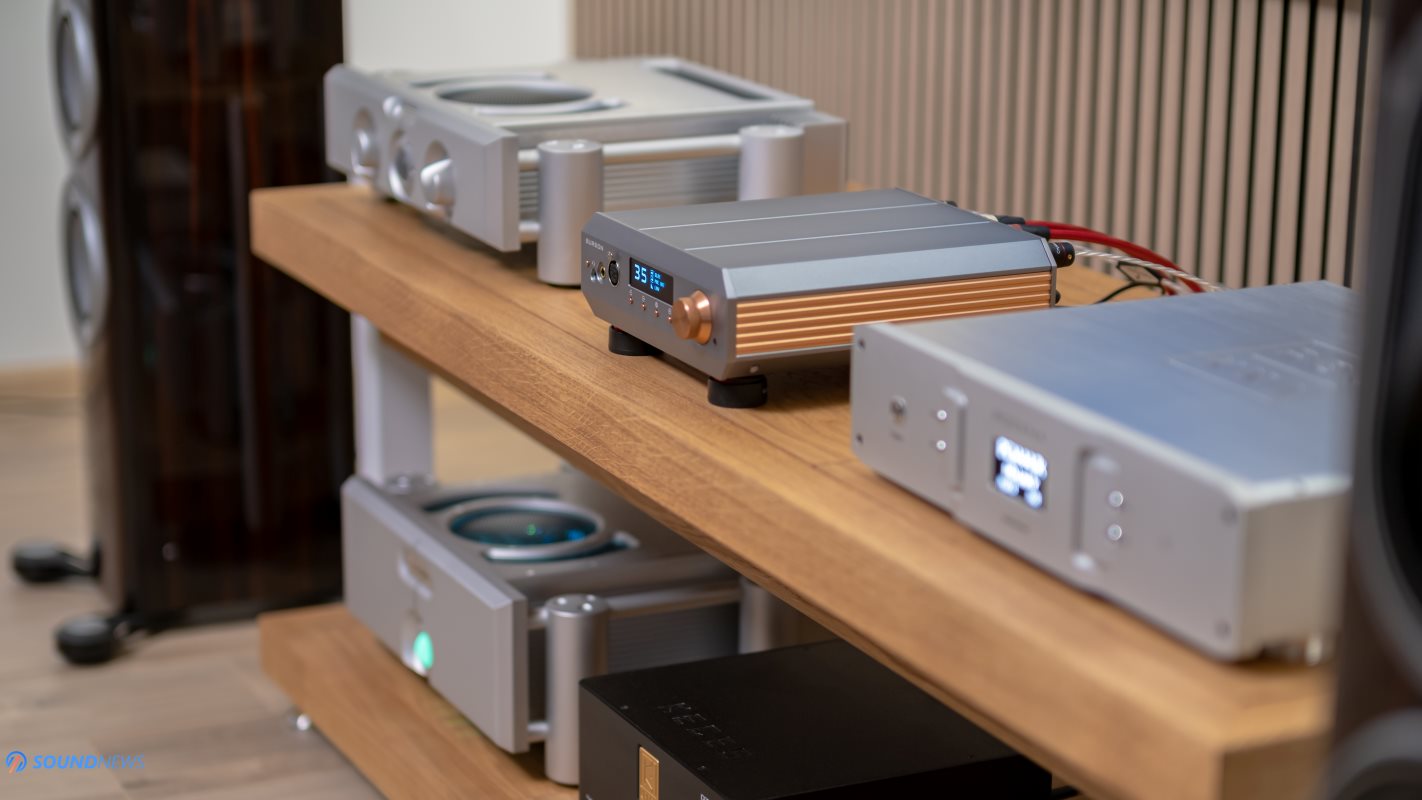
V. Dynamics & Transients
Nasty. Furious. Boner-inspiring.
People have their own words to describe the sound of an amplifier, but when it comes to Burson-made ones, these guys are always turning it up to eleven dynamics-wise. You might want to play a little with its tonality, swapping discrete op-amps with V7 variants or with third-party offerings, but there’s one thing you won’t tone down and don’t wanna change, and that’s the insatiable desire to kick your eardrums. It does it hard, nasty, furious, and quite…boner-inspiring if you’re a lover, a true music lover. It so happens that, most, if not all Burson made amps passed through these hands. Yep, even the ones destined to drive passive loudspeakers and while there were always ways of improving them little by little, one step at a time, there’s no improving their painful kick in the nuts.
I know, not everyone seeks this kind of performance, that opens the dance floor for you, but if you like being bombarded with all sorts of sounds, not only hearing but literally feeling them with your whole body, then this fellow gets easily a 10 out of 10. We can agree to disagree on many things, on its tonality, scale, and imaging, but we’ll always agree on one thing: wild dynamics are part of its DNA, inherited from a long line of amplifiers. You can get more power at this price, and you can get even a slightly bigger soundstage, but when it comes to simple things like resolution and dynamics, then the Voyager plays a forever-alone game. At least for now.
Infected Mushroom is going to release their 18th studio album tomorrow – can’t wait for that to happen. However, they’ve made available two tracks for about a month now. If you’re into perfectly executed psytrance that’s mastered as high standards, then you have to try these mushroom-picking guys. Dream Theater is mostly ethereal and airy, especially when using headphones, but the real kicker is Release Me REBORN (Qobuz / Tidal) which fires machine gun like notes with pretty much all of my headphones. The Susvara is the lowest-sensitivity can in my possession and if it does justice to this track, then all others will follow the same course of action. Following these two tracks with a few Astrix masterpieces, almost feels like my limbs have a mind of their own, bypassing my commands and starting their dance parties. There’s no fricking way you won’t smile, tap a foot or nod your head while listening to these tunes, and well, the Voyager helps reach that state brilliantly.
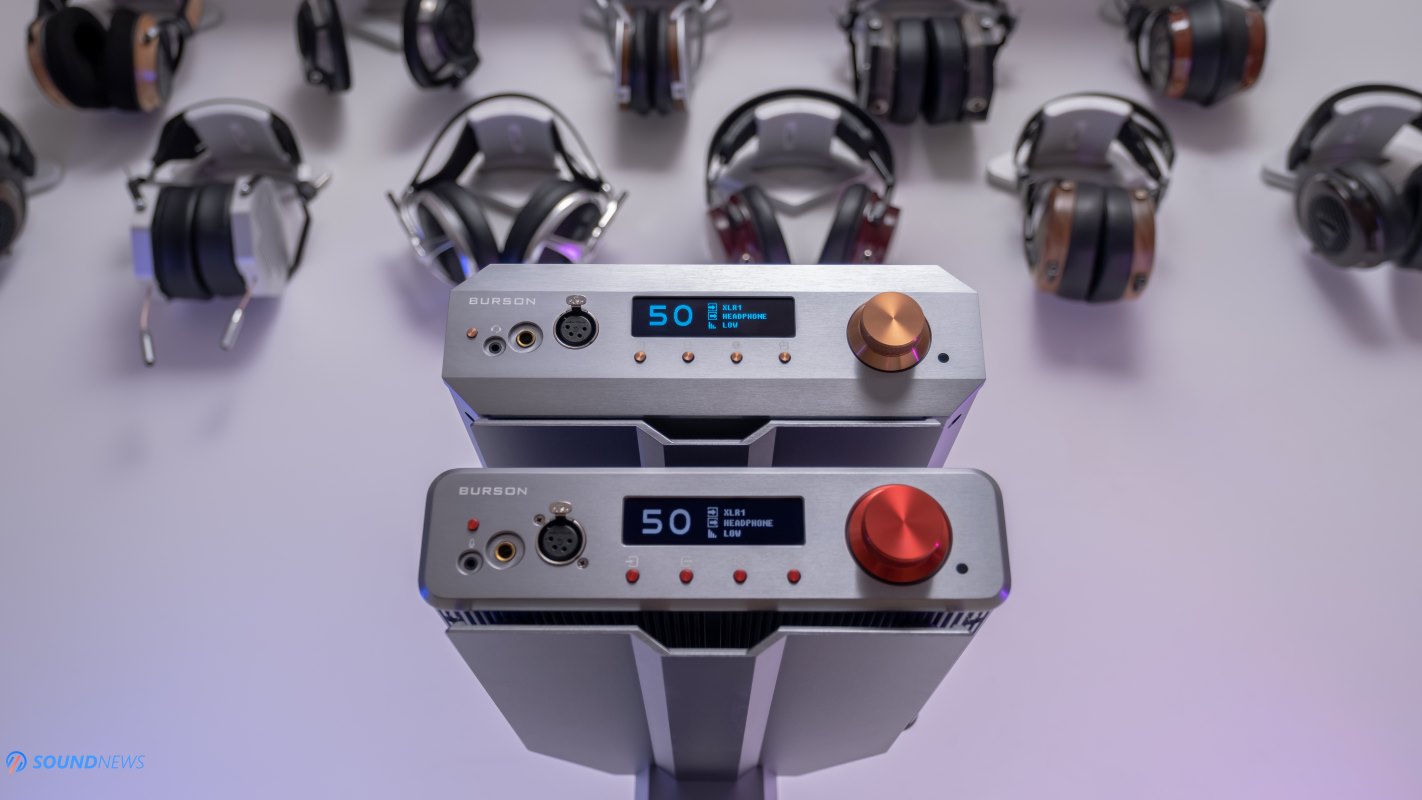
VI. Resolution / Detail Retrieval
I kind of like The Transient Response Guy and The DACMan monikers, funny names people came up with, representing me. The transients will always boil inside my veins and I will be always chasing for faster and harder slamming units out there. I do, however, love playing with different D/A converters. Not for a perfect system matching (although that is still one of the reasons), but for getting the last drop of information from my tunes. After two decades of trying some of the oldest and newest D/A converters, I arrived at the Chord Electronics DAVE and the Rockna Wavedream Signature, although I must confess that currently, I like the Rockna a bit more. Why? The resolution feels infinite, the imagining and soundstage is the best I have experienced so far and so are the transients, always running wild.
These digital creatures are considerably more expensive than the Voyager, which seems to be in very good company, and I’m sure that I’m feeding it the cleanest signal I can offer at this moment. I am not surprised that the resolution bump has a direct effect on the Voyager, as clearly, more nuances start appearing in the most unusual places, but mostly on a micro level – things that usually don’t reveal their faces to the listener. Macro-dynamics are fine even on entry to mid-level devices, but when it comes to micro-dynamics, where faint quantities of air will be passing by, then only world-class DACs and amplifiers will be revealing such things to you.
By the book, fully discrete amplifiers with long signal paths are not the cleanest sounding ones, but with clever engineering and careful part selection, everything’s possible! I had plenty of resolution monster amplifiers around here, from affordable ones (Topping A90D / A70 PRO) to pricier (Benchmark HPA4) and much pricier ones (Enleum AMP-23R). However, it seems that the resolution races aren’t as fierce nowadays, getting plenty of resolution even out of ~$400 units. After browsing a good deal of recordings, it was clear to me that the Voyager sits on the same table with some of the cleanest preamps and headphone amps that have been tested around here and I don’t need several days of back-and-forth comparisons, to know exactly how clean, unspoiled and pure it sounds on all accounts.
Besides updated circuitry and pure Class-A operation, the Voyager still boasts an impressive analog volume control buffered with a set of V7 Vivid PRO ICs per channel, eliminating the interference between them. Add SP-02 Silent Power modules, the Super Charger 5A and we are getting the sound of silence in between passages and infinite intricacies when dynamics are going higher.
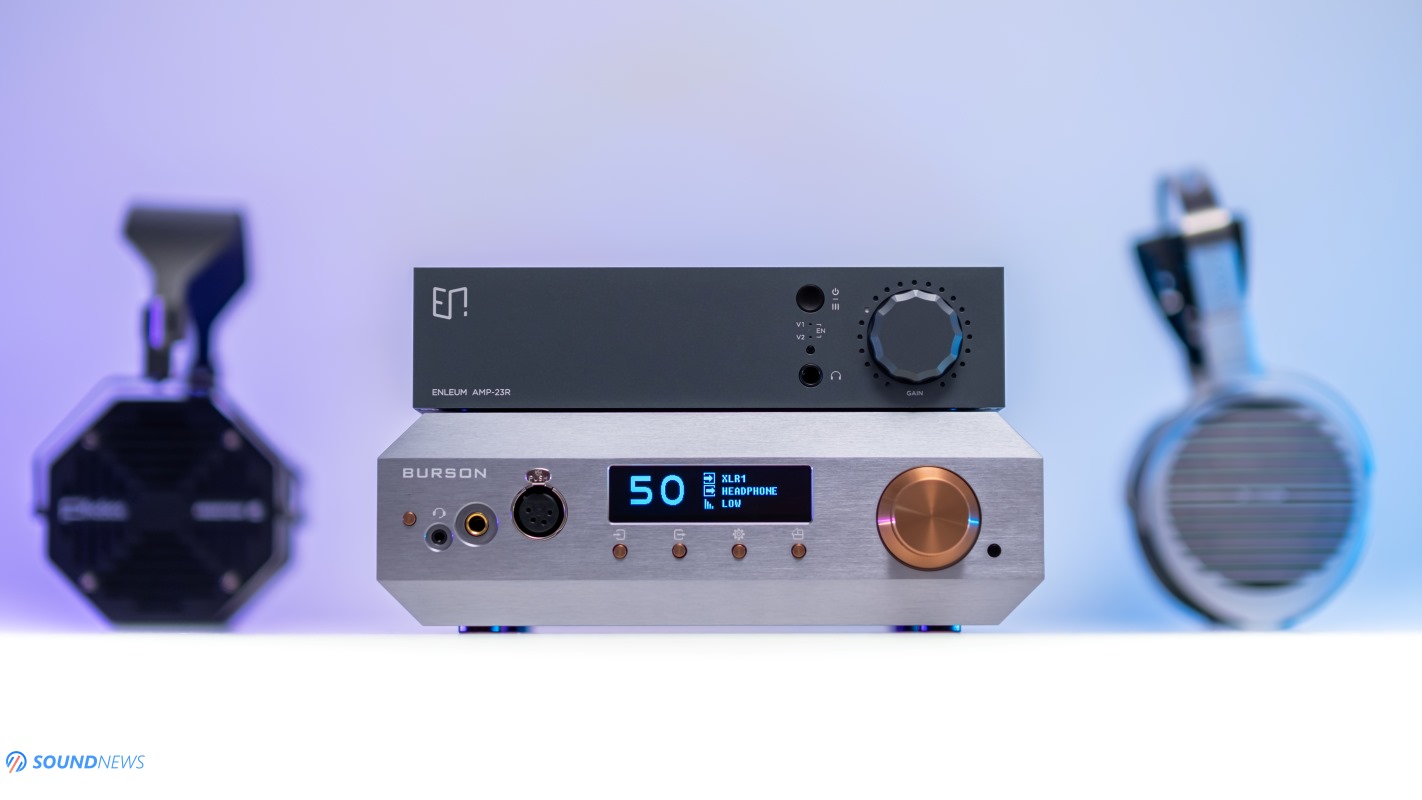
VII. Imaging & Soundstage
The most controversial topic of headphone listening – is the sound that is hovering all around you or the so-called, soundstage. If you’re new to this concept and if you’re a strong believer in measurements, then I’m sorry to be disappointing you, but there isn’t such a measurement that tells how big or small the soundstage is. This part is usually measured by our tiny brains, which are more capable than you might think. The same goes for transients and while impulse response is somewhat hinting about how fast a unit will sound, our minds are the ones to hail or blame when subjectively judging an amplifier’s performance.
Obviously, the biggest gains you’ll be getting from the headphones and loudspeakers themselves, but still, believe it or not, the amplifier that drives them can have a massive impact on the scale of the music. The biggest sounding amplifier, by far, without the rights to appeal from other contenders is still the Trafomatic Primavera, which I usually use in the winter time, and when it comes to solid-state electronics, the Volot by Flux Lab Acoustics is still the only one that gives me similar double triode-like vibes, sounding vast and extremely holographic.
From Burson’s portfolio, as I have already mentioned, there are no pot-holes that will be stopping the sound from reaching its fullest potential and naturally, the sound is now bigger than ever. I won’t say it’s by orders of magnitude bigger and deeper sounding than the Soloist 3X GT, but it’s definitely by a hair bigger sounding regardless of the quality of the recording. Rockna’s Wavedream Siganture gives a massive boost on the X and Y axle, putting the sounds on individual shelves to be picked up by the listener and I’m glad that the Voyager is scaling up or down, depending on what source drives it and what source material is being used.
On a scale of 1 to 10, where 10 is the largest sounding amplifier, Primavera gets a 10, Volot a 9, the Voyager a solid 8.5 and so does the Enleum AMP-23R.
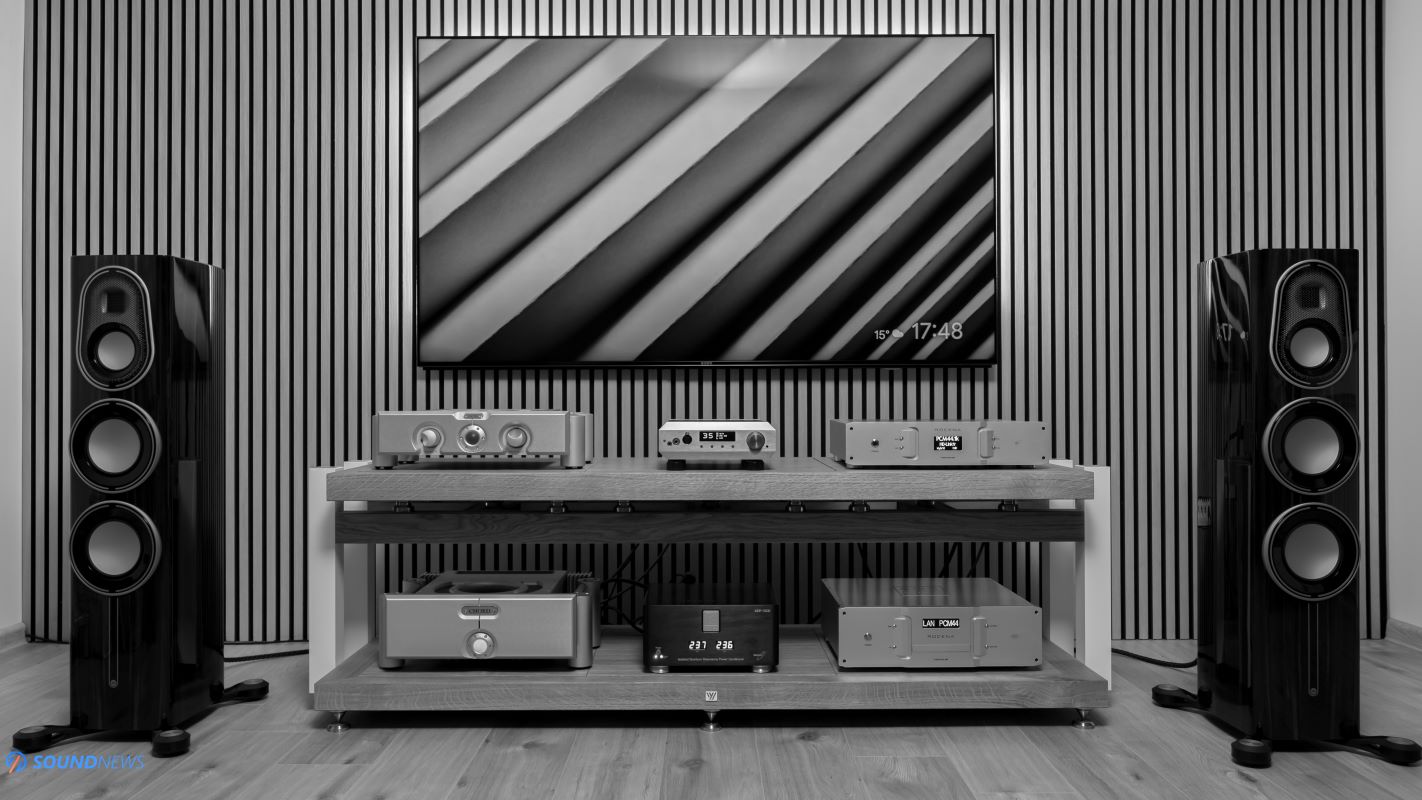
VIII. Soloist Voyager working as a Preamp in a Stereo Setup
As it turned out, the Soloist 3X GT not only worked great as a headphone amp but also as a preamp. You might think that a DAC with a volume control already offers a decent preamplifier section, but that’s a false affirmation most of the time. There is quite a difference sound-wise between a digital attenuator and a true analog line-amplifier circuit when directly driving a power amplifier (or two), followed by passive loudspeakers. I’ve been using digital attenuators for a while now and while the channel balance is always perfect and the noise was never a concern, the sound never had the balls, the crazy dynamics, and the spaciousness of dedicated line-amplifier circuits. A dedicated preamplifier will have more control over the low-end and more energy will be oozing from your loudspeakers. I had a secret meeting with Rob Watts of Chord Electronics some time ago, we discussed their DAVE and Rob explained why it already has a spectacular preamplifier section. However, the amp building team from the same company was telling me a (very) different story, that a dedicated preamp put in between the DAVE and the power amp, would do wonders. I felt like sitting between the hammer & the anvil, borrowing a Chord Ultima 3 preamp the same day out of curiosity, and $10K later, the rest is now history. It elevated the DAVE to such grounds that I promised to never use the volume attenuators or oversimplified preamp stages of D/A converters ever again.
The same thing happened with the Voyager, but having slightly more current available for output transistors, a slightly clearer performance, and a wider soundscape, everything combined made it a better preamplifier than the Soloist 3X GT. Burson’s Timekeeper GT mono blocks are currently playing tunes at one of my friends, meaning that I will be using Chord’s Ultima 5 (~$16.000) power amp, ditching the Ultima 3 Pre (~$9000) in favor of the Voyager.
To my surprise, there wasn’t a massive difference sound-wise as the price might suggest. The resolution was very similar, I didn’t notice a drop in perceived inner detail, the sound was nicely breathing and most importantly, dynamics didn’t go down on the Voyager. Monitor Audio’s Platinum 200 G3 were pounding hard the entirety of my body and quick shifts in dynamics weren’t sluggish or out of pace. Dynamics and resolution were neck and neck, and the only two differences were in terms of scale/soundstage and overall tone of the music. Ultima 3 Pre always sounds Grand (with a capital letter), it’s always huge on all axes, and with bookshelf speakers, I’m always getting this weird feeling that somebody swapped bookshelves with stand floors. The sound is truly expanding in all directions and nothing holds it back. The Voyager wasn’t exactly as open and grand sounding, although it didn’t lack air around the notes and I won’t call it closed-in or claustrophobic. Another change was the overall tonality of the unit. The DAVE is extremely detailed, hence getting the “Analogue Veritas in Extremis” leitmotif, needing warmth and sweetened coming from upstream equipment and that’s exactly what Ultima 3 Pre is doing. Chord’s Preamplifier puts even more meat on the bone, especially in the midrange section, literally transforming dull and thin-sounding loudspeakers into true music-making machines, adding lots of body and soul into the mix.
Now, the Voyager also has such traits, but those are not pushed to the extreme. Overall, the Voyager should work with a wider variety of power amplifiers, since it’s a more “honest” sounding preamplifier, whereas Ultima 3 pre is a more “colored” sounding preamplifier that adds lots of body, soul, and sweetness to the overall affair.
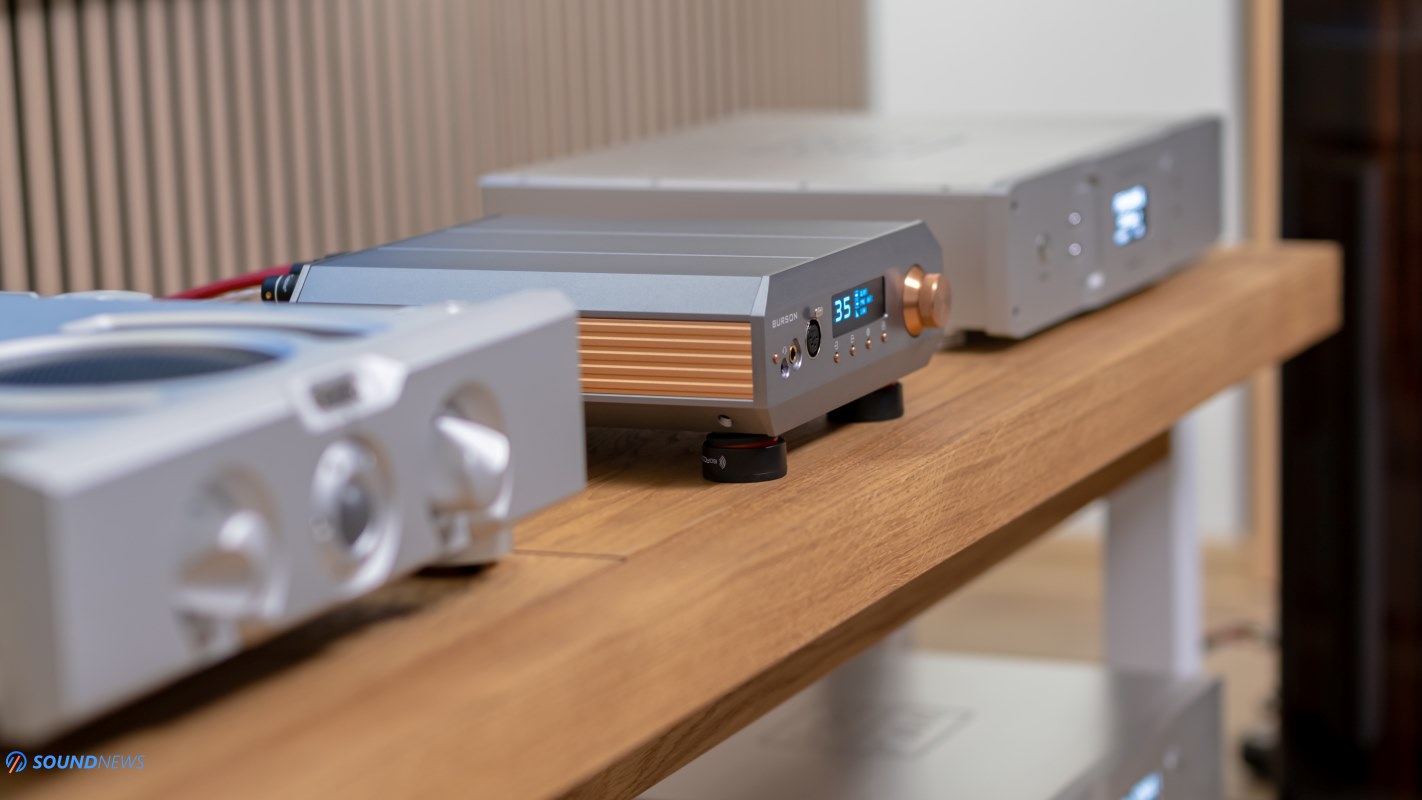
Frequency Response
IX. Bass
Two headphones from my collection have small difficulties in rendering bass energy, needing extra power and oomph not only for a stronger bass delivery but also for greater control over the lowest frequencies. Sennheiser’s HD800S are usually blooming with mid-range OTL or high-class transformer-coupled tube amplifiers. From my experience with them, solid-state amplifiers will need to have something truly special to awaken their bass notes from a deep slumber. Ferrum’s OOR, Enleum’s AMP-23R, and Flux Lab Acoustic’s Volot, truly shined in this department, with the Soloist 3X GT sitting somewhere in between the second and the third place in my rankings. The Voyager soars a little higher compared to the Soloist 3X GT and it’s currently exchanging blows with the Enleum AMP-23R for first place, in terms of quality and quantity of the bass. It’s a real challenge complaining about its bass definition and kick when your ears are flapping to the rhythm of the music. Every Burson amplifier has been impressive in the bass department and the Voyager is no different, gently improving on its qualities more than ever, especially in the control department. The second headphone that needs so much more current than voltage, is the HiFiMan Susvara. I’m an electronic music addict, these tunes are part of my daily audiophile diet and naturally, I wanted the absolute control, cleanness, sustain, and decay of the bass. As I have already mentioned multiple times by now, the Susvaras were fully juiced up and perfectly controlled, there weren’t more ladders to climb when rendering bass energy and information. A job very well done!
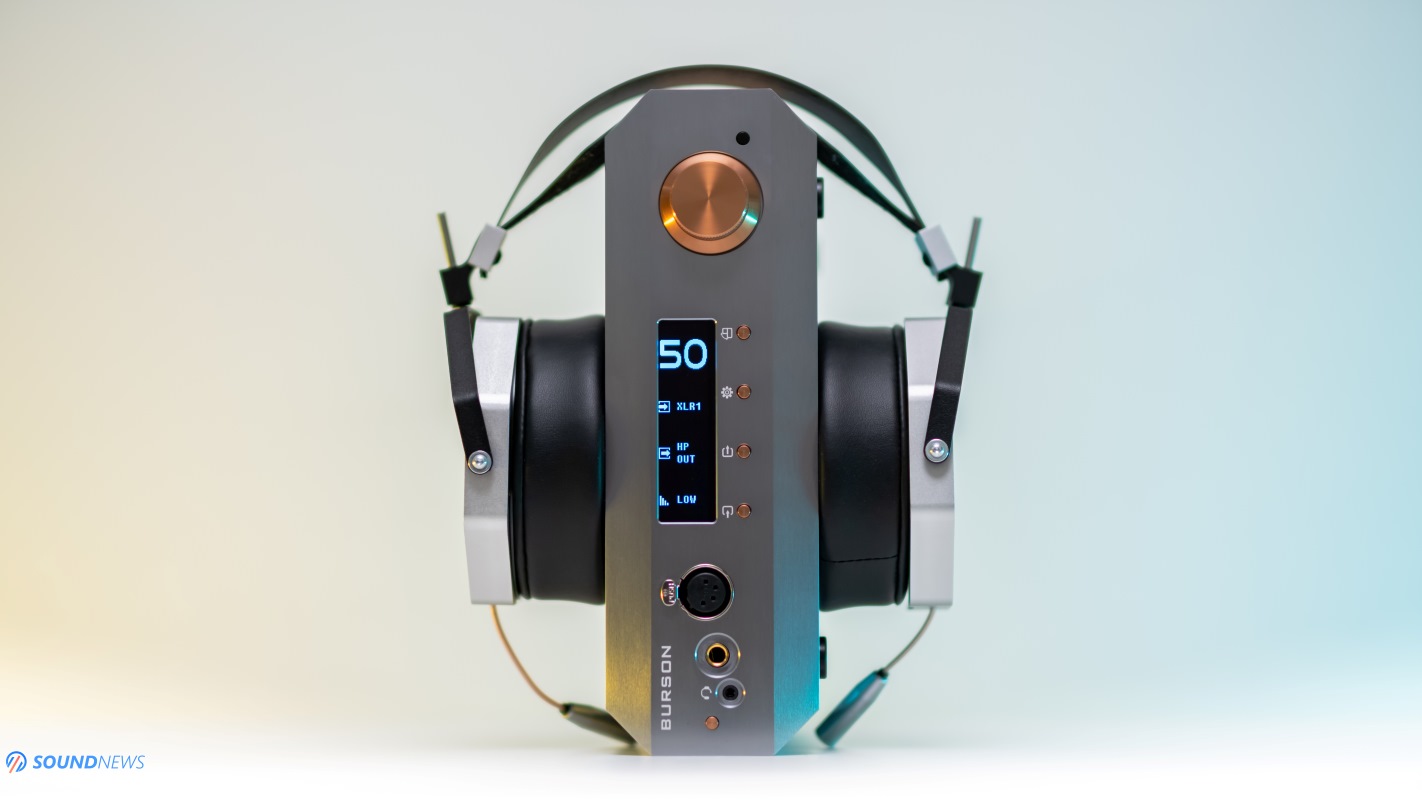
X. Midrange
Etta James comes up on the playlist, a recording that seems older than myself. The best of Etta James no less. The recording is all muddy and unrefined, you could easily hear the hiss, and the noise floor was so much higher than the usual 21st-century records, but God damn! Before opening her mouth, I could almost feel her firing up two cigarettes and handing me one, tasting her lipstick on it. Suddenly, my heart pounds so loud, that I can’t hear any other sound, coming from either headphones or loudspeakers and I know, it sounds crazy, but with the V7 Classics PRO in place, every dirty record transforms into an experience, working you out. From the inside. Ah, the beautiful midrange that does unthinkable things to us, music lovers. It’s clearer all right, it’s more saturated as well, and it’s even sweeter than it ever was before. I don’t want her out of my office and I’m sure as hell, that Etta will be singing tomorrow and the day after tomorrow and I will be again smoking a cigarette and tasting her lipstick. The midrange is indeed quite a departure from the good old Burson sound, there’s more life in it, more emotion, and depending on who you are, you’re either laugh or cry, stand and applaud, or just recline your chair and add another track on your playlist. From the golden armada of headphone amplifiers and preamplifiers released almost on a weekly basis, from the solid-state crowd in particular, I still hold the highest fully-discrete designs that don’t use negative feedback. Feedback or not, the Voyager soars on everything that has to do with midrange and you’ll probably crack a smile on these words, but man, things have changed for the better for these Aussies. Keep’em crafting guys, keep the fire blazing.
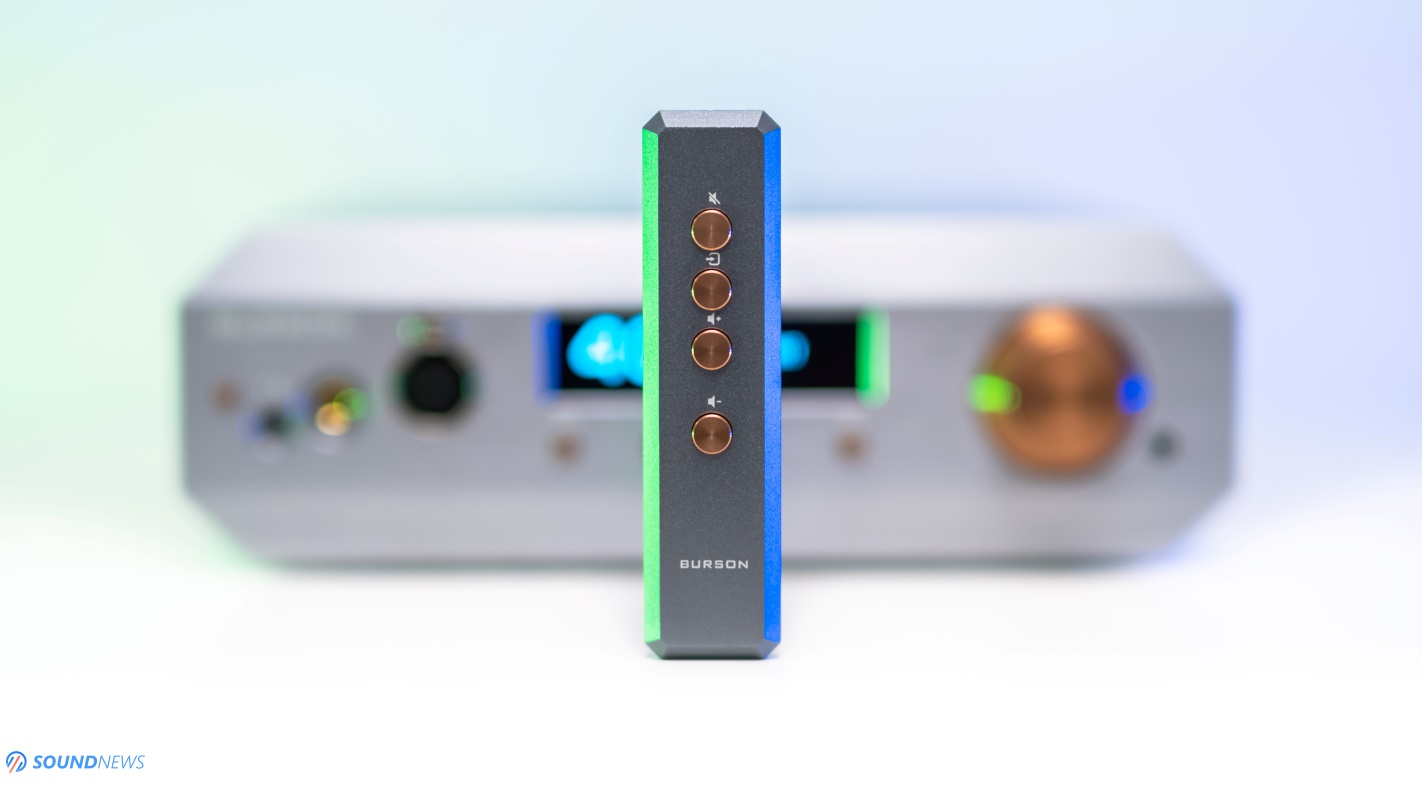
XI. Treble
Now, I need to confess that this was the only region I could nod my head and complain a little. I don’t know from where tiny traces of sharpness were coming on their Soloist 3X GT first or second edition, but clearly, something made them a little sharper sounding compared to the rest of the crowd. The trebles were fine, but sometimes, I found them a little hotter than usual. The V6 Classics were calming my spirits and the treble region as well, and many adventurers went even further trying out third-party ICs, which weren’t fully supported on Burson amplifiers, only to tame that blazing fire and tone it down a little. From 2019 to recent years, you needed to think about a careful system matching that would counterbalance their cons, by using R2R or FPGA DACs, or tubed-DACs that would slightly roll off the upper treble and make it smoother and calmer at the end of the day. Cut from the same cloth, the Voyager is surprisingly, a different animal, even with the V7 Vivid PRO preinstalled. Poof! There’s no brightness or digitus! The system matching is no longer necessary, the trebles are exactly as clear or even more, and the extension is even better, but the cymbals are no longer drilling a hole and rattling your skull. Years later, Burson Audio found a balance and hopefully, they’ll stick to it, remembering their roots when Burson was synonymous with a full-bodied, weighty, and textured sound.
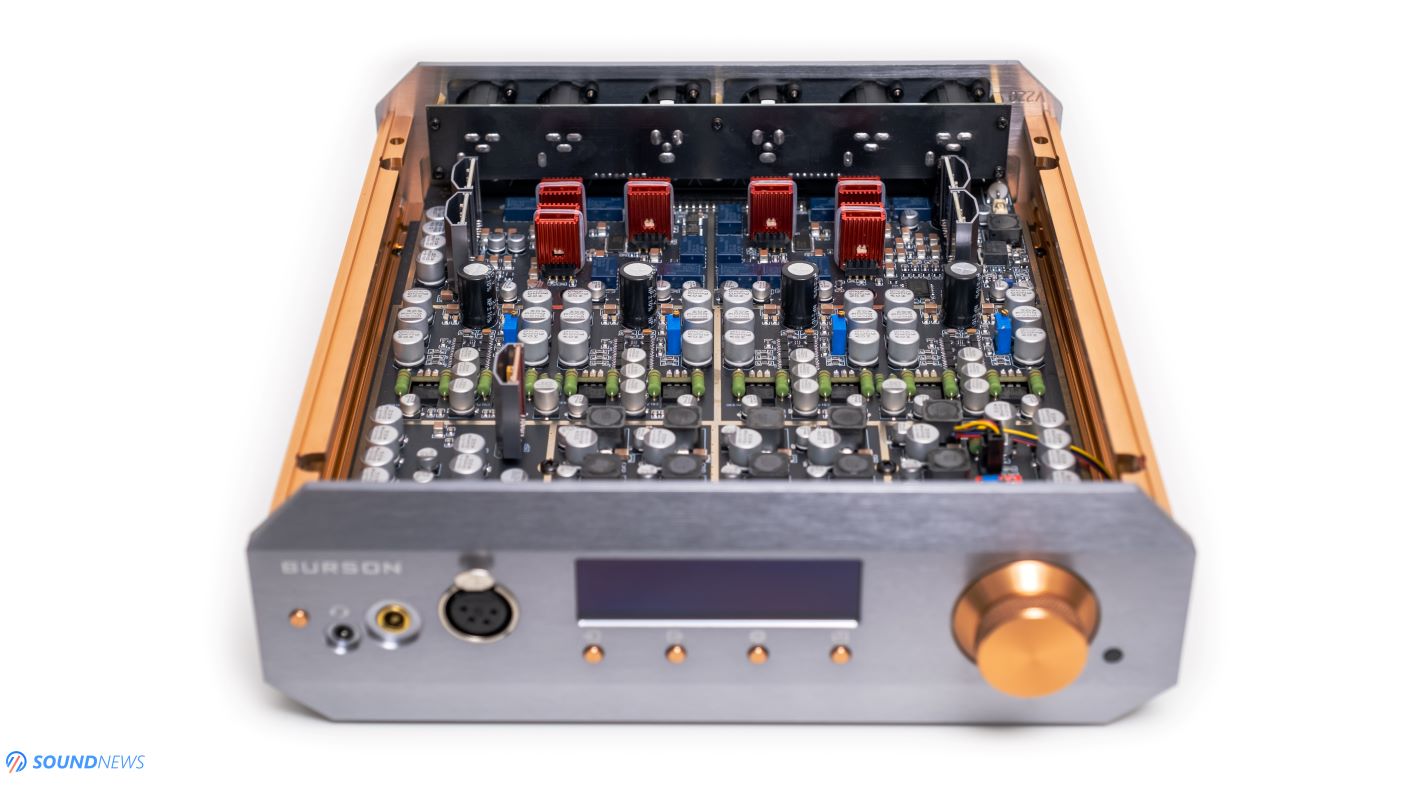
Wrapping Up
There’s one thing that stops me from hyping it to cloud nine. One thing that didn’t make it worse or better sounding. One small complaint that might not even bother you long term and that’s the temperature of the bottom plate and around the lateral heatsinks, getting around ~60°C. All those components were made to resist 100°C on a 24/7 basis, so in truth, we are far from a fire hazard, but I’d wish it would be a little cooler, so I could at least touch it for a minute. I’m currently using Iso-Pucks Mini for a higher elevation and a small fan is blowing in its direction – something that I’m already doing with the Trafomatic Primavera and Enleum AMP-23R, getting exactly as hot. This is just an observation, so please treat it accordingly.
Apart from this minor drawback, Burson is already dining with the best names in the business. There is no denying that it performs at a higher level compared to anything they’ve done before, even if spec-wise we are getting the same power ratings. A watt is rarely equal to a watt, as we always have different voltage and current values, and while this is still a 10-Watt per channel full-discrete and fully-balanced headphone amplifier and preamplifier, this is a higher quality power compared to that coming from the Soloist 3X GT 2023.
However, you’ll need to decide for yourself if jumping from the Soloist 3X GT to the Voyager is worth the time and investment for a slightly better unit all around, but if you love your 3X GT to death and want just a bit more technicalities, all while being more natural and organic sounding, then upgrading to the Voyager feels like the right thing to do.
For the newcomers that never tried a Burson-made unit, you have eleven chapters dedicated to sound quality. Those are telling you the full story, the unspoiled truth and if everything resonated with you, then I wholeheartedly recommend getting the Voyager. The full might of the Voyager was revealed with the V7 Vivid PRO and Classic PRO op-amps in place and if you already have the budget for the standard version, then I’d suggest stretching your budget and getting the Deluxe package instead that includes the very best Burson Audio has to offer.

Undoubtedly, Soloist Voyager fully deserved our highest Gold Award and I’m looking forward to the next signs in the sky for new developments. It can be yours for $3.499 and the Deluxe package will cost you $4199 directly from Burson Audio right here.
In case you are getting one, please let me know in the comments section below, and don’t forget to press that Subscribe button over YouTube, it means a lot to me. That’s all for now, Sandu’s singing out!
PROS:
- A fresh-looking unit with a rock-solid build quality
- Advanced feature set, simple looking UI, and all the I/O you can wish for
- One of the cleanest sounding all-discrete Class-A headamp and preamp that passed through my hands
- The soundstage is now airier than ever, and the depth improved little by little, always sounding big and quite holographic
- While the background noise is still there with ultra-sensitive IEMs, it’s no longer there with regular IEMs and the menu no longer triggers higher noise levels
- The resolution king headphone amp, along with the AMP-23R by Enleum
- Covers the frequency response in full, while planting a bit more life in the midrange and oomph in the bass versus the Soloist 3X GT
- Easily drove my entire headphone collection, leaving a ton of headroom on tap
- Crazy wild, nut-kicking dynamics!
- Excellent pre-amplifier section that wasn’t far off from a much pricier preamp
- Has incredible control over headphone and speaker drivers, works nicer with high-impedance dynamic headphones
- The sound is refined and effortless on all accounts as if the amp never stresses to do its main job
- This is a highly technical, yet engaging-sounding unit at all times
CONS:
- The Deluxe version is pricier, but well worth the extra
- Gets hot after about an hour of use
ASSOCIATED EQUIPMENT:
- DACs: Chord Electronics DAVE, Rockna Wavedream Signature XLR, Gold Note DS-10 PLUS & PSU-10 EVO
- Wireless Streamer & Music Server: Rockna Wavedream NET 4TB, EverSolo DMP-A8
- Headphone Amps: Burson Audio Soloist Voyager, Soloist 3X GT 2023, Trafomatic Primavera, Enleum AMP-23R, Ferrum OOR & HYPSOS, Flux Lab Acoustics Volot & Mentor
- IEMs: Westone Mach 50, Hiby ZETA, FiiO FX15, HiFiMan Svanar, 7Hz Timeless AE, Kinera Skuld & others
- Full-sized headphones: Meze Elite & 109 PRO, Erzetich Charybdis & Phobos V.2021, HiFiMan Susvara, Arya Organic, Audivina, Sennheiser HD800S, Kennerton Rognir (planar) & Vali, Apos Caspian, Sendy Peacock & Apollo, HarmonicDyne Elite & Poseidon, others
- Preamps: Burson Audio Soloist Voyager, Chord Electronics Ultima 3 Pre
- Power Amps: Chord Electronics Ultima 5, Burson Timekeeper 3X GT (x2)
- Loudspeakers: Monitor Audio Platinum 200 G3, Raidho TD 2.2 (incoming)
- Interconnects: Crystal Cable Reference2 Diamond (x3), QED Reference (x2), Topping TCX1 (x2)
- USB Cables: Supra USB Excalibur (x2), Chord C-USB, Matrix Hi-Fi USB
- HDMI Cables: Audioquest Diamond DBS, Supra 8K HDMI
- Speaker cables: Kimber PR8, Audioquest Type4
- Power Cables: Crystal Cable Reference2 Diamond (x3), Isotek EVO3 Premier (x2), iFi Audio SupaNova (x2)
- Balanced Isolation Power Conditioners: PLiXiR Elite BAC1500 (headphone setup), KECES IQRP-1500 and P14 (stereo setup)
